Adele
Electrical Technology: Power Systems Questions - Grade 12 September 2021 Preparatory Exams
INSTRUCTIONS AND INFORMATION
- This question paper consists of SEVEN questions.
- Sketches and diagrams must be large, neat and FULLY LABELLED.
- Show ALL calculations and round off answer correctly to TWO decimal places.
- Number the answers correctly according to the numbering system used in this question paper.
- You may use a non-programmable calculator.
- Show the units for ALL answers of calculations.
- A formula sheet is provided at the end of this question paper.
- Write neatly and legibly.
QUESTIONS
QUESTION 1: MULTIPLE-CHOICE QUESTIONS
Various options are given as possible answers to the following questions. Choose the answer and write only the letter (A–D) next to the question numbers (1.1 to 1.15) in the ANSWER BOOK, for example 1.16 A.
1.1 To prevent infection when treating burns, the following should NOT be done:
- Do not take a pain killer
- Do not pop blisters
- Do not use a sterile gauze or bandage
- Do not hold the burned area under cool running water (1)
1.2 In a purely capacitive circuit, the relationship between the voltage and current is as follows:
- The current leads the voltage
- The current lags the voltage
- The current and voltage are in phase
- The current is zero (1)
1.3 During resonance the ...
- inductive reactance is greater than capacitive reactance.
- capacitive reactance is greater than inductive reactance.
- impedance is equal to 1.
- inductive reactance is equal to capacitive reactance. (1)
1.4 In a 240 V, 50 Hz RCL circuit with an inductance of 50 mH, the inductive reactance is equal to …
- 151,7 Ω.
- 151,7 H.
- 15,71 Ω.
- 15,71 H. (1)
1.5 The phase angle between the coils in a three-phase system is:
- 120°
- 180°
- 270°
- 90° (1)
1.6 Real power per phase is:
- The product of the current and the voltage
- The product of I sin ? and the voltage
- The product of I cos ? and the voltage
- The product of the resistance and the voltage (1)
1.7 A low power factor is usually caused by …
- the capacitive loads of a consumer.
- the inductive loads of a consumer.
- no load of a consumer.
- the resistive loads of a consumer. (1)
1.8 Transformers can operate when connected to …
- an AC supply only.
- a DC supply only.
- either an AC or a DC supply.
- a rectifier circuit. (1)
1.9 When operating three single phase transformers as a three-phase transformer, the following characteristic does not have to be identical:
- The frequency
- The voltage
- The current
- The colour (1)
1.10 In a forward-reverse starter, interlocking contacts are used to …
- keep the circuit energised after the start button has been released.
- show the operator which contactor is in operation.
- prevent the other contactor being energised while the motor is running in one direction.
- switch the power off when excessive currents occur (1)
1.11 The readings for an insulation resistance test between windings should be:
- At least 100 Ω
- At least 1M Ω
- At least 500 Ω
- None of the above-mentioned (1)
1.12 The direction of rotation of a three-phase motor is reversed by …
- changing the voltage.
- changing the load.
- changing the size of the conductors used.
- swopping any two of the three supply lines. (1)
1.13 A PLC is an …
- industrial computer that is programmed to perform a number of tasks in a strict order.
- industrial starter used to operate relays.
- industrial appliance which reads outputs to control inputs.
- industrial switch that works with electromagnetism. (1)
1.14 An opto-isolator is a semiconductor device that uses …
- heat to transfer an electrical signal between circuits.
- sound to transfer an electrical signal between circuits.
- light to transfer an electrical signal between circuits.
- electromagnetism to transfer an electrical signal between circuits. (1)
1.15 The following step is part of the PLC’s scan cycle:
- Barcode scan
- Process scan
- Voltage scan
- Frequency scan (1)
[15]
QUESTION 2: OCCUPATIONAL HEALTH AND SAFETY
2.1 Give the meaning of the following with reference to the Occupational Health and Safety Act, 1993 (Act 85 of 1993).
2.1.1 Risk (1)
2.1.2 Safe (1)
2.2 Explain the difference between quantitative risk analysis and qualitative risk analysis.(5)
2.3 State ONE example of a dangerous practice in an electrical workshop. (1)
2.4 Explain how inadequate lighting is an unsafe condition. (2)
[10]
QUESTION 3: RLC CIRCUITS
3.1 Draw a neat, labelled characteristic curve showing the relationship between the inductive reactance and the frequency in a pure inductive circuit. (2)
3.2 State the relationship between the capacitive reactance and the frequency in a pure capacitive circuit. (1)
3.3 Define the term phase angle with reference to RLC circuits. (2)
3.4 FIGURE 3.4 below shows the phasor diagram of the voltages and current in a series circuit. Answer the questions that follow.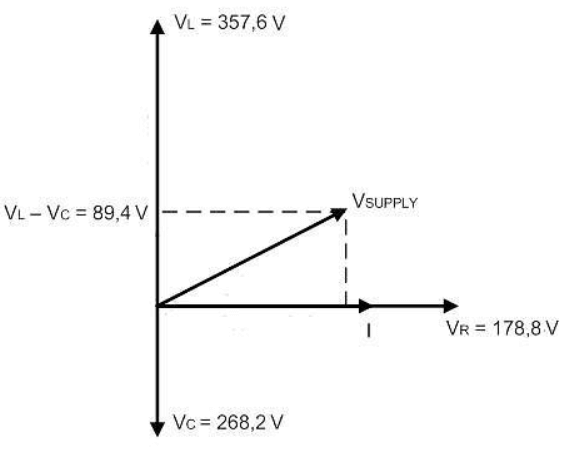
FIGURE 3.4
3.4.1 State with reference to the current, whether the phase angle is leading or lagging. (1)
3.4.2 Calculate the value of the supply voltage. (3)
3.4.3 Explain when the current would be in phase with the voltage of the circuit. (2)
3.5 State where resonant circuits are used. (1)
3.6 Describe the differences between the characteristics of series and parallel resonance. (2)
3.7 The series RLC circuit in FIGURE 3.5 consists of a 22 Ω resistor, an inductor of 50 mH and a capacitor with a reactance of 42,44 Ω. The series combination is connected to a 110 V/50 Hz supply. Answer the questions that follow.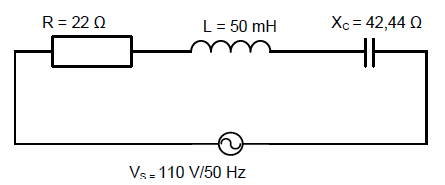
FIGURE 3.5
Given:
- R = 22 Ω
- L = 50 Mh
- X? = 42,44 Ω
- VS = 110 V
- f = 50 Hz
Calculate:
3.7.1 The inductive reactance (3)
3.7.2 The impedance of the circuit (3)
3.7.3 The value of the capacitor in the circuit in micro-farad (4)
3.8 Refer to FIGURE 3.8 below and answer the questions that follow.
FIGURE 3.8
Given:
- IR = 10 A
- IL = 3,54 A
- C = 100 µF
- VS = 100 V
- f = 25 Hz
Calculate:
3.8.1 The current flowing through the capacitor (5)
3.8.2 The total current flowing through the circuit (3)
3.8.3 The phase angle (3)
[35]
QUESTION 4: THREE-PHASE AC GENERATION
4.1 State why the conductors of overhead transmission lines are made of aluminium and steel. (2)
4.2 Name the device that is used to measure the electrical energy consumed by a residence or business. (1)
4.3 Give THREE disadvantages a low power factor has for the consumer of electricity. (3)
4.4 Refer to FIGURE 4.4 below and answer the questions that follow.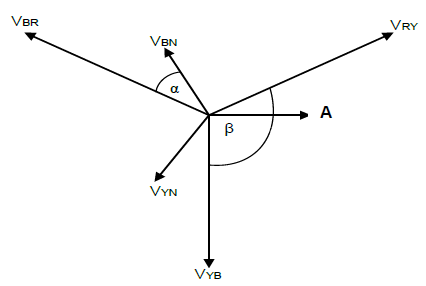
FIGURE 4.4
4.4.1 Identify the diagram shown in FIGURE 4.4. (1)
4.4.2 Write down the values of the angles α and β. (2)
4.4.3 Label the part A as shown in the diagram. (1)
4.4.4 Explain how the neutral is created in this system. (1)
4.4.5 Determine the value of VYB if VYN = 219,395 V (3)
4.5 A three-phase star connected system has a phase voltage of 220 V. The system has a rated power of 12 kW at a power factor of 0,87. The efficiency of the system is 86%.
Given:
- VPH = 220 V
- POUT = 12 kW
- cos ? = 0,87
 = 86%
= 86%
Calculate:
4.5.1 The line voltage (3)
4.5.2 The input power (3)
4.5.3 The line current (3)
4.6 A three-phase system with an apparent power of 30 kVA has a line and a phase voltage of 400 V. The system draws a current of 43,3 A and the lagging power factor causes a phase angle of 25°.
Given:
- S = 30 kVA
- VL = 400 V
- VPH = 400 V
- IL = 43,3 A
- ? = 25°
Calculate:
4.6.1 The real power (3)
4.6.2 The reactive power (3)
4.6.3 The phase current (3)
4.6.4 The power factor (3)
[35]
QUESTION 5: THREE-PHASE TRANSFORMERS
5.1 Name ONE application of the following:
5.1.1 Star-delta transformers (1)
5.1.2 Delta-star transformers (1)
5.2 State how the oil used in transformers can contribute to excessive heating. (2)
5.3 Describe the construction of a three-phase shell type transformer. (3)
5.4 Name TWO of the most common internal failures of three-phase transformers. (2)
5.5 A 50 kVA three-phase transformer has copper losses of 250 W and core losses of 180 W. The system operates at a power factor of 0,8.
Given:
- S = 50 kVA
- copper losses = 250 W
- core losses = 180 W
- cos ? = 0,8
Calculate:
5.5.1 The output power (3)
5.5.2 The efficiency of the transformer (3)
5.6 A three-phase delta-star transformer has a primary line voltage of 11 kV and delivers an output power of 25 kW at a power factor of 0,8. The turns ratio is 44 : 1.
Given:
- VLP = 11 kV
- POUT = 25 kW
- cos ? = 0,8
- Turns ratio = 44 : 1
Calculate:
5.6.1 The secondary phase voltage (4)
5.6.2 The secondary line voltage (3)
5.6.3 The secondary line current (3)
5.6.4 The secondary phase current (2)
5.6.5 The rating of the transformer (3)
[30]
QUESTION 6: THREE-PHASE MOTORS AND STARTERS
6.1 FIGURE 6.1 below shows a block diagram of the power transfer in an induction motor. Answer the questions that follow.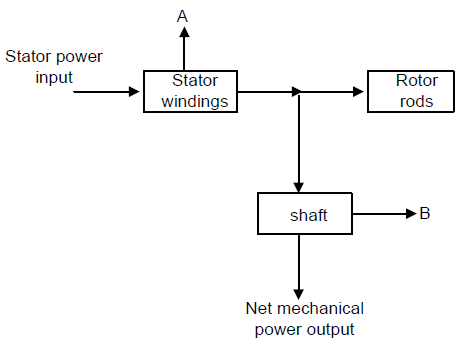
FIGURE 6.1: BLOCK DIAGRAM OF THE POWER TRANSFER IN AN INDUCTION MOTOR
6.1.1 Name the losses that occur at A and B. (2)
6.1.2 State THREE other parts a three-phase motor consists of, that are not shown in the block diagram above. (3)
6.2 Write down the name given to the difference between the rotor speed and the rotating magnetic field of the stator. (1)
6.3 Redraw the terminal box below in your ANSWER BOOK, then show the box connected in delta to the supply. (3)
(3)
6.4 Describe the operation of the star-delta starter control circuit. (6)
6.5 Draw a neatly labelled circuit diagram of the control circuit of a three-phase forward-reverse starter. The contactors are rated at 220 V. (11)
6.6 A three-phase motor with two pole pairs per phase is connected to a 380 V supply. The rotor speed is 1 440 rpm and the synchronous speed is
1 500 rpm. The output power at a power factor of 0,85 is 5 kW.
Given:
- ? = 2
- V = 380 V
- NR = 1 440 rpm
- NS = 1 500 rpm
- cos ? = 0,85
- POUT = 5 Kw
Calculate:
6.6.1 The slip in rpm (3)
6.6.2 The frequency of the supply (3)
6.6.3 The line current at the rated output power (3)
[35]
QUESTION 7: PROGRAMMABLE LOGIC CONTROLLERS (PLC’s)
7.1 Define the following terms with reference to PLCs:
7.1.1 Hard wiring (1)
7.1.2 Scan time (2)
7.2 Draw a neatly labelled sketch showing the principle of a photo-transistor. (5)
7.3 Answer the following questions with reference to the OR logic gate.
7.3.1 Draw the logic symbol for this gate. (2)
7.3.2 Complete the truth table in FIGURE 7.3.2 below by ONLY writing the state of the output next to the letter in the ANSWER BOOK, for example e – 1.
 (3)
(3)
FIGURE 7.3.2: TRUTH TABLE
7.3.3 Draw the ladder diagram that represents this gate. (3)
7.4 State TWO examples of each of the following with reference to PLCs:
7.4.1 Input devices (2)
7.4.2 Output devices (2)
7.5 Refer to the FIGURE 7.5 below and answer the questions that follow.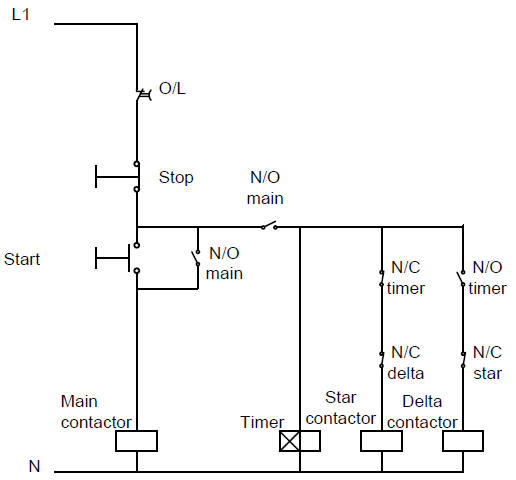
FIGURE 7.5
7.5.1 Draw a labelled ladder logic diagram of the circuit. (12)
7.5.2 Explain the function of the two normally closed contacts connected in series with the star and delta contactors. (2)
7.5.3 Explain why the circuit remains energised after the start button is released. (2)
7.5.4 Describe the function of the timer in the circuit. (1)
7.6 Draw a labelled block diagram showing a variable speed drive connected to a three-phase motor. (3)
[40]
TOTAL: 200
FORMULA SHEET
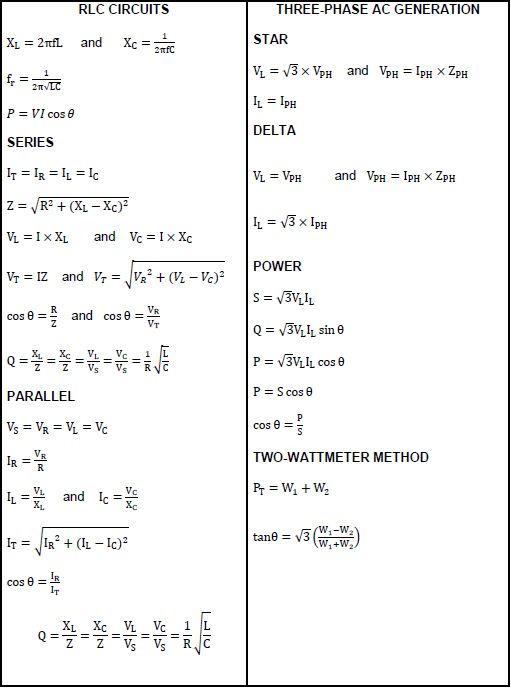
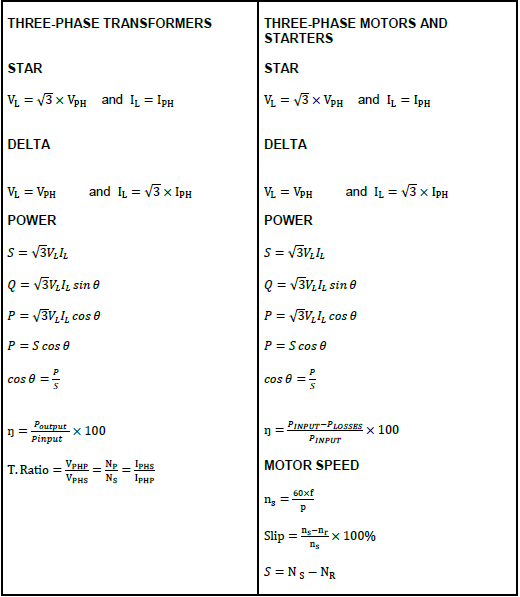
Electrical Technology: Digital Electronics Memorandum - Grade 12 September 2021 Preparatory Exams
INSTRUCTIONS TO MARKERS
- All questions with multiple answers imply that any relevant, acceptable answer should be considered.
- Calculations
2.1 All calculations must show the formulae.
2.2 Substitution of values must be done correctly.
2.3 All answers MUST contain the correct unit to be considered.
2.4 Alternative methods must be considered, provided that the correct answer is obtained.
2.5 Where an incorrect answer could be carried over to the next step, the first answer will be deemed incorrect. However, should the incorrect answer be carried over correctly, the marker has to re- calculate the values, using the incorrect answer from the first calculation. If correctly used, the candidate should receive the full marks for subsequent calculations.
2.6 Markers should consider that candidates' answers may deviate slightly from the marking a guideline depending on how and where in the calculation rounding off was used. - These marking guidelines are only a guide with model answers.
- Alternative interpretations must be considered and marked on merit. However, this principle should be applied consistently throughout the marking session at ALL marking centres.
MEMORANDUM
QUESTION 1: MULTIPLE-CHOICE QUESTIONS
1.1 A (1)
1.2 A (1)
1.3 C (1)
1.4 D (1)
1.5 D (1)
1.6 C (1)
1.7 D (1)
1.8 C (1)
1.9 C (1)
1.10 A (1)
1.11 B (1)
1.12 A (1)
1.13 C (1)
1.14 A (1)
1.15 D (1) [15]
QUESTION 2: OCCUPATIONAL HEALTH AND SAFETY
2.1
2.1.1 The probability that injury or damage will occur. (1)
2.1.2 Free from any hazard. (1)
2.2 In quantitative risk analysis an attempt is made to numerically determine the probabilities of various adverse events and the likely extent of losses if a particular event took place. Qualitative risk analysis defines the various threats determining the extent of vulnerabilities and devising counter measures should a risk occur. (5)
2.3 Use or misuse of power tools. Incorrect use and handling of hand tools. Etching of printed circuit boards. (1)
2.4 Inadequate lighting leads to poor visibility, which could lead to dangerous situations or injuries. (2)
[10]
QUESTION 3: SWITCHING CIRCUITS
3.1
3.1.1 Bistable multivibrator (1)
3.1.2 It protects the LED from drawing to much current and getting damaged. (1)
3.1.3 When RESET is pressed, pin 4 is pulled to ground. This resets the IC and cause it to change state with the output falling to LOW. (3)
3.1.4 The low value capacitor (0,1µF) is used to remove any unwanted and stray signal from the circuit. The will prevent noise in the circuit. (3)
3.1.5
- The two inputs would be floating between +V and 0 V.
- When the SET or RESET button is pushed it would short circuit the supply to ground. (2)
3.2 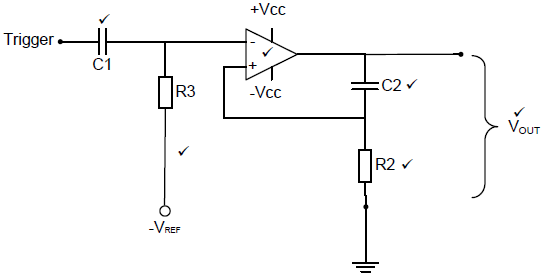 (6)
(6)
3.3
- Change the value of the timing capacitor.
- Change the value of the timing resistor.
- Change the values of both the timing capacitor and the timing resistor. (3)
3.4 Switch bounce can be eliminated by using a monostable multivibrator circuit to control the output. (1)
3.5 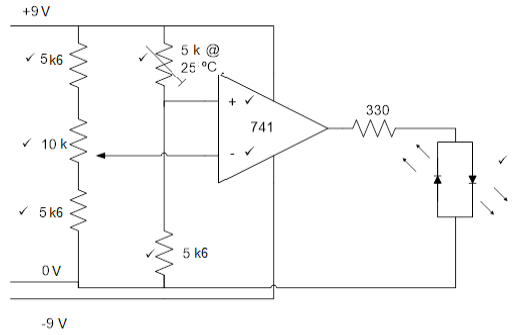 (8)
(8)
3.6
- The less light on the LDR, the higher the resistance.
- The more light on the LDR, the lower the resistance. (4)
3.7
3.7.1 Open loop gain refers to a circuit with no feedback from the output back to the input. (2)
3.7.2
- Voltage divider resistors R1 and R2 set up the reference voltage VREF.
- The reference voltage is fed back to the non-inverting input of the Op-amp.
- The comparator compares the input voltage VIN to the reference voltage VREF.
- The gain of the Op-amp is ±100 000 because of the open loop connection.
- Whenever there is a fraction of a millivolt difference between VIN and VREF, this difference will be amplified.
- The Op-amp will be driven into either one of the saturation states.(6)
3.8
3.8.1 By adding another input resistor to the summing amplifier input. (1)
3.8.2 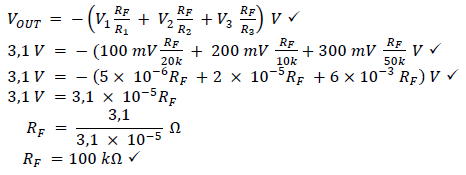 (4)
(4)
3.8.3 It is negative because the inputs are fed into the inverting input, which will cause the output to be 180° out of phase. (1)
3.9 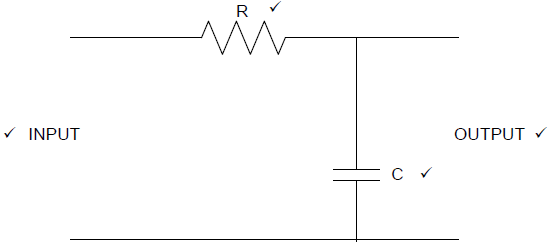 (4)
(4)
[50]
QUESTION 4: SEMICONDUCTOR DEVICES
4.1
- Differential Amplifier
- High Gain Differential Amplifier
- Common Collector Output 4 (3)
4.2 Positive Supply (+V) (1)
4.3 The op-amp should be able to amplify any input of any frequency, from 0 Hz through to radio frequency and higher. This is not practical and the gain drops at higher frequencies. This is due to internal capacitances in the op-amp’s chip. (4)
4.4
- Very high input impedance.
- Very low output impedance. (2)
4.5 This pin is used to allow a different charge voltage level to be introduced to the 555 timer rather than the usual 2/3 point. This pin is normally either not connected or else it is connected to ground via a small value capacitor which removes any unwanted noise from the supply voltage that might affect the timer operation. (4)
4.6 This capacitor will remove any unwanted noise from the supply voltage which could affect the operation of the timer. (2)
4.7
- Two comparators
- S/R flip-flop (2)
4.8
- Monostable
- Astable
- Bistable (Any 2 x 1) (2)
[20]
QUESTION 5: DIGITAL AND SEQUENTIAL DEVICES
5.1
- Common Anode – The anodes of the LED’s are all connected to the positive supply.
- Common Cathode – The cathodes of the LED’s are connected to ground. (4)
5.2.1
- ?0 = 1
- ?1 = 0
- ?2 = 0
- ?3 = 0 (4)
5.2.2
- ?0 = 1
- ?1 = 0
- ?2 = 1
- ?3 = 0 (4)
5.2.3 The outputs of FIGURE 4.3 will be ZERO if all input switches are switched OFF. (2)
5.3.1 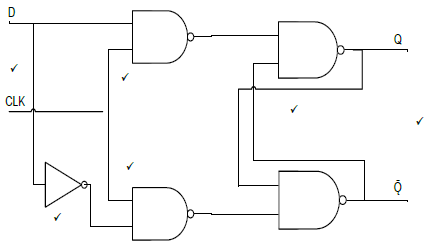 (6)
(6)
5.3.2 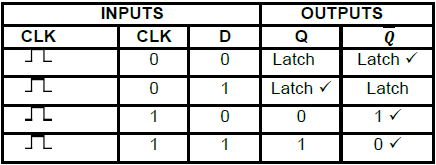 (4)
(4)
5.4
- Robotics
- Computer Numeric Control (CNC) machines. (Any 1 x 1) (1)
5.5 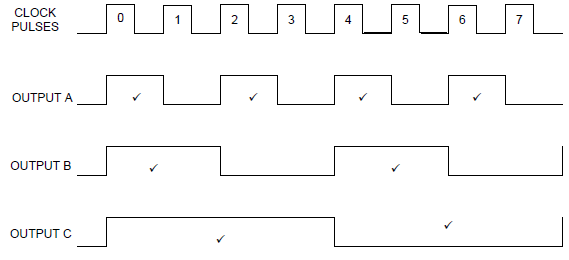 (8)
(8)
5.6 The JK flip flops are not triggered at the same time causing their outputs not to change states at the same time. (3)
5.7 The timing signal is delayed through each flip-flop. (2)
5.8
- It slows the counter down.
- It introduces errors into the system. (2)
5.9 They are slower due to the propagation delay through the additional gates in the system. (2)
5.10
- Full sequence counter – This counter will count until its maximum count.
- Truncated counter – This counter will stop before reaching its maximum count. (4)
5.11
- Frequency divider
- Decade counter
- Binary coded decimal counter (Any 2 x 1) (2)
5.12.1 8 clock pulses (1)
5.12.2 4 clock pulses (1)
5.12.3 1 clock pulse (1)
5.13 All four bits of the input will simultaneously be loaded to the input of all the flip-flops. After one clock pulse each flip-flop will shift its input to its output. This process will repeat itself for four clock pulses so that the complete 4-bit input is available at the output. (4)
[55]
QUESTION 6: MICROCONTROLLERS
6.1
- Industrial instrumentation
- Monitoring
- Process control
- Cooling systems (Any 2 x 1) (2)
6.2 The RAM stores all the data that is required to be processed by the CPU during the execution of programs. (2)
6.3 The ROM contains information that is permanently required. It holds the programs, operating systems and data required by the system to be booted
up when it is turned on. (2)
6.4
6.4.1 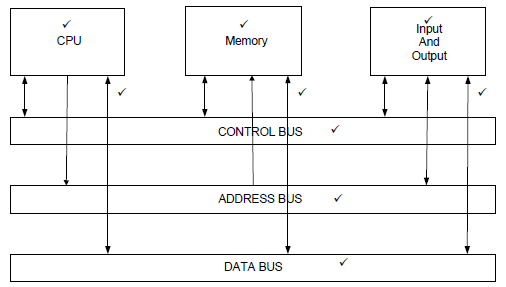 (9)
(9)
6.4.2 A shared boundary across which two separate components of a computer system exchanges information. (2)
6.5
6.5.1 It counts the number of instructions that have been executed, adding one each time. (3)
6.5.2 The MAR stores the address of the next instruction to be executed by the processor. (2)
6.6 RS 232 or RS 485 (1)
6.7 Communication protocol is a set of rules that allow two electronic devices to connect and exchange data. (2)
6.8.1 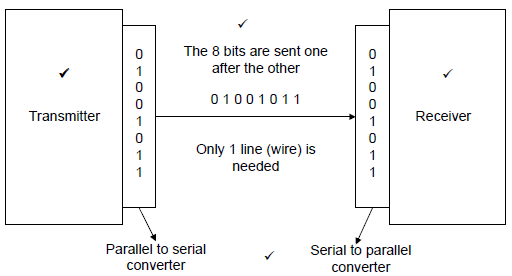 (4)
(4)
6.8.2 All 8 bits are sent together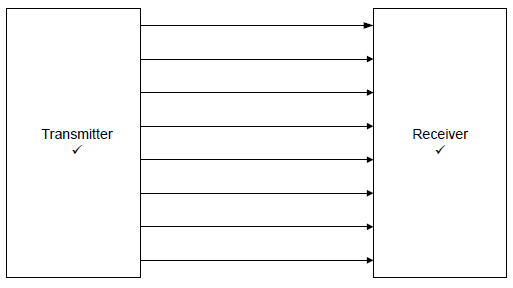
8 Lines are used (4)
6.9.1 UART is a Universal Asynchronous Receiver Transmitter (1)
6.9.2 This communication peripheral sends and receives data serially. It converts parallel data to a serial data string and vice versa through the RX/TX line. (4)
6.10.1 A flowchart is a pictorial version of an algorithm and illustrates the flow of a program. (2)
6.10.2 An algorithm is a precise set of procedures to be followed to solve a problem. (2)
6.10.3 In the cycle, the CPU fetches a program instruction from its memory, decodes the instruction, considers all inputs and then executes that instruction. (3)
6.11.1 Data (1)
6.11.2 Process (1)
6.12  (1)
(1)
6.13 It represents any type of data input or output in a flowchart. (2)
[50]
TOTAL: 200
Electrical Technology: Digital Electronics Questions - Grade 12 September 2021 Preparatory Exams
INSTRUCTIONS AND INFORMATION
- This question paper consists of SIX questions.
- Sketches and diagrams must be large, neat and FULLY LABELLED.
- Show ALL calculations and round off answers to TWO decimal places.
- Number the answers correctly according to the numbering system used in this question paper.
- Answer the following questions on the attached ANSWER SHEETS:
QUESTION 5.2.1
QUESTION 5.2.2
QUESTION 5.3.2
QUESTION 5.5 - You may use a non-programmable calculator.
- Show the units for ALL answers of calculations.
- A formula sheet is provided at the end of this question paper.
- Write neatly and legible.
QUESTIONS
QUESTION 1: MULTIPLE CHOICE QUESTIONS
Various options are given as possible answers to the following questions. Choose the answer and write only the letter (A–D) next to the question numbers (1.1 to 1.15) in the ANSWER BOOK, for example 1.16 A
1.1 To prevent infection when treating burns the following should NOT be done:
- Do not take a pain killer
- Do not pop blisters
- Do not use a sterile gauze or bandage
- Do not hold the burned area under cool running water (1)
1.2 With reference to a monostable multivibrator, the time an output stays high is determined by:
- The time constant (RC)
- The length of time you push the button
- The magnitude of the supply voltage
- It will stay high indefinitely (1)
1.3 The Bistable multivibrator has the following characteristics:
- Free running with ONE input
- Free running with TWO inputs
- TWO stable states with TWO inputs
- NO stable states with ONE input (1)
1.4 A Light Dependant Resistor (LDR) will change value due to:
- Wind blowing on the LDR
- Current flowing through the LDR
- A voltage drop across the LDR
- The change of light shining on the LDR (1)
1.5 The output waveform of a Schmitt trigger circuit will always be a:
- Sine wave
- Triangular wave
- Radio wave
- Square wave (1)
1.6 Pin 1 of an Integrated Circuit (IC) is indicated by the following:
- A white ‘1’ on the IC
- Two blue lines on the IC
- An indent with a dot to the left of the indent
- The pin is red in colour (1)
1.7 The maximum current a 555 IC can either sink or source is:
- 2 A
- 200 A
- 2 Ma
- 20 Ma (1)
1.8 With reference to the LED seven segment display, common anode refers to:
- The anodes of all eight LED’s are connected together to a common ground rail.
- The cathodes of all eight LED’s are connected together to a common positive rail.
- The anodes of all eight LED’s are connected together to a common positive rail.
- None of the above. (1)
1.9 The function of a decoder is to …
- convert analogue signal to a digital signal.
- convert a digital signal to an analogue signal.
- convert a binary code into a recognisable decimal form.
- convert a decimal code into a recognisable binary form. (1)
1.10 Pulse triggered flip-flop circuits are also referred to as:
- Master/Slave
- Follow my lead
- Simultaneous trigger
- Continuous trigger (1)
1.11 The term ‘full sequence counter’ refers to:
- A counter that counts from 0 to 5
- A counter that runs to its maximum count
- A counter that is interrupted during the count
- A counter that stops counting at 2 (1)
1.12 With reference to microcontrollers, a … is an example of an input.
- sensors
- motors
- monitors
- LED display (1)
1.13 The term ‘CPU’ refers to:
- Common Programming Unit
- Central Programming Unit
- Central Processing Unit
- Common Processing Unit (1)
1.14 The term ‘Debugging’ refers to:
- To identify and remove errors
- To find bugs and kill them
- To find bugs and remove them
- All of the above (1)
1.15 The Inter-Integrated Bus (I2C) is an official standard serial communication protocol that requires only …
- 4 lines.
- 3 lines.
- 1 line.
- 2 lines. (1)
[15]
QUESTION 2: OCCUPATIONAL HEALTH AND SAFETY
2.1 Give the meaning of the following with reference to the Occupational Health and Safety, 1993 (Act 85 of 1993).
2.1.1 Risk (1)
2.1.2 Safe (1)
2.2 Explain the difference between quantitative risk analysis and qualitative risk analysis. (5)
2.3 State ONE example of a dangerous practice in an electrical workshop. (1)
2.4 Explain how inadequate lighting is an unsafe condition. (2) [10]
QUESTION 3: SWITCHING CIRCUITS
3.1 With reference to FIGURE 3.1 below, answer the following questions.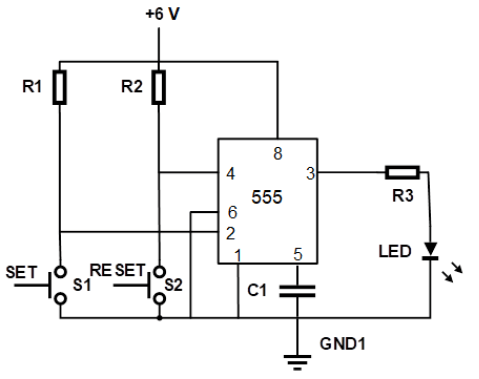
FIGURE 3.1: MULTIVIBRATOR
3.1.1 Identify the circuit in FIGURE 3.1 above. (1)
3.1.2 State the function of R3. (1)
3.1.3 Describe what happens when the RESET switch, S2 is pressed. (3)
3.1.4 Explain the purpose of C1 which is connected to ground from pin 5. (3)
3.1.5 Explain what the effect would be on the circuit if R1 and R2 were not added to the circuit. (2)
3.2 Draw a fully labelled circuit diagram for a monostable multivibrator op-amp circuit. (6)
3.3 Explain how you would vary the length of time that a monostable multivibrator circuit output stays ‘HIGH’. (3)
3.4 Explain how to eliminate switch bounce. (1)
3.5 Draw a fully labelled circuit diagram for a temperature sensor using a 741 op-amp. (8)
3.6 Explain the principle of operation of a Light Dependant Resistor (LDR). (4)
3.7 Refer to FIGURE 3.7 below and answer the questions that follow.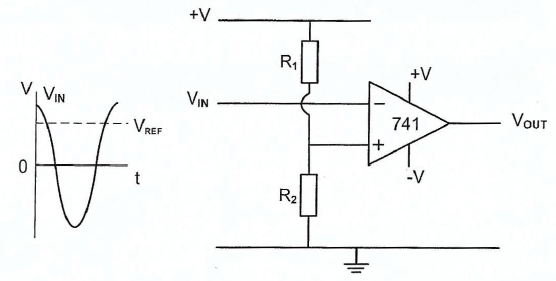
FIGURE 3.7: COMPARATOR
3.7.1 Explain what is meant with open loop with reference to FIGURE 3.7. (2)
3.7.2 Describe the principles of operation of a comparator. (6)
3.8 Refer to FIGURE 3.8 below and answer the questions that follow.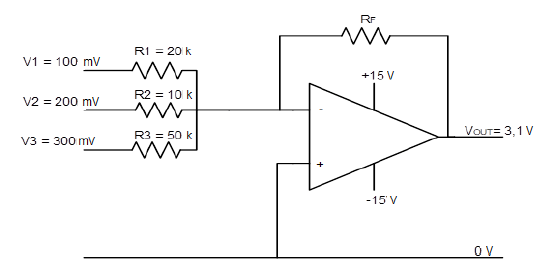
FIGURE 3.8: SUMMING AMPLIFIER
3.8.1 State how an input signal can be added to the summing amplifier. (1)
3.8.2 Calculate the value of the feedback resistor (RF). (4)
3.8.3 State why the output voltage is negative in FIGURE 3.8. (1)
3.9 Draw the circuit diagram for a passive integrator. (4)
[50]
QUESTION 4: SEMICONDUCTOR DEVICES
4.1 Name the THREE stages of an op-amp. (3)
4.2 Identify Pin 7 of a 741 op-amp. (1)
4.3 With reference to op-amp characteristics, explain the term bandwidth. (4)
4.4 Explain why an op-amp as a voltage follower is an ideal coupling stage (buffer) between two unevenly matched stages. (2)
4.5 With reference to 555 IC, explain the function of pin 5 (control voltage). (4)
4.6 Explain the function of using a small value capacitor connected from pin 5 to ground on a 555 IC. (2)
4.7 Name the TWO primary building blocks of a 555 IC. (2)
4.8 Name TWO modes the 555 IC is set up to function in. (2)
[20]
QUESTION 5: DIGITAL AND SEQUENTIAL DEVICES
5.1 Refer to the LED seven-segment display and explain the difference between a common anode and a common cathode.
(4)
5.2 Refer to FIGURE 5.2 below and determine the binary code at the output when the following input switches are pressed. Write the answers on ANSWER SHEETS 5.2.1 and 5.2.2.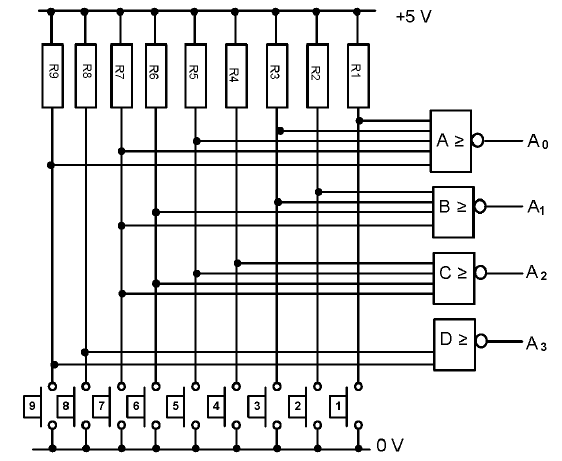
FIGURE 5.2: DECIMAL-TO-BINARY ENCODER
5.2.1 Switch 1 (4)
5.2.2 Switch 5 (4)
5.2.3 Briefly describe the STATE of the input switches if all outputs are ZERO. (2)
5.3 FIGURE 5.3 below represents the logic symbol of a clocked D-type flip-flop.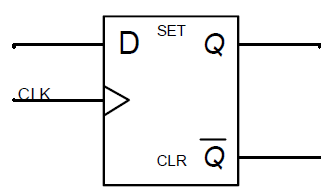
FIGURE 5.3
5.3.1 Draw the logic circuit of this flip-flop using NAND gates, NOR gates and an inverter. (6)
5.3.2 Complete the truth table of this flip-flop in TABLE 5.3.2 on ANSWER SHEET 5.3.2.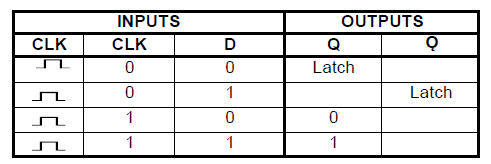 (4)
(4)
TABLE 5.3.2
5.4 State ONE application of the up/down counter. (1)
5.5 FIGURE 5.5 below shows a three-stage asynchronous ripple counter. Complete the timing diagram on ANSWER SHEET 5.5.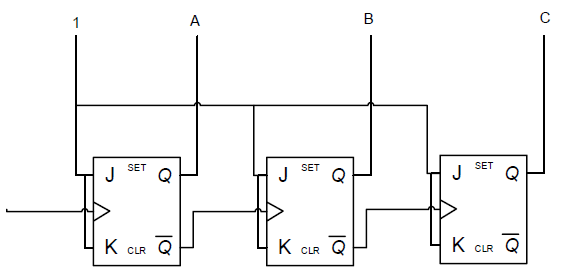 (8)
(8)
FIGURE 5.5: ASYNCHRONOUS RIPPLE COUNTER
5.6 Explain why the circuit in FIGURE 5.5 is called asynchronous. (3)
5.7 With reference to counters, explain the term propagation delay. (2)
5.8 Name TWO disadvantages of propagation delay. (2)
5.9 Explain the disadvantage of up/down counters in relation to normal up or down counter. (2)
5.10 Explain the difference between a full sequence counter and a truncated counter. (4)
5.11 Name TWO applications of counters. (2)
5.12 State how many clock pulses the following shift registers need to shift a 4-bit input from the input to the output. Each shift register consists of four D-type flip-flops.
5.12.1 Serial in-serial out shift register (SISU) (1)
5.12.2 Serial in-parallel out shift register (SIPO) (1)
5.12.3 Parallel in-parallel out shift register (PIPO) (1)
5.13 Explain how a parallel in-serial out shift register (PISO) consisting of four D-type flip-flops will shift a 4-bit input to the output. (4)
[55]
QUESTION 6: MICROCONTROLLERS
6.1 State TWO uses of a microcontroller in industrial control devices. (2)
6.2 State the basic function that the random access memory (RAM) performs. (2)
6.3 State the basic function of a read-only memory (ROM). (2)
6.4 Refer to communication in a microcontroller and answer the questions that follow.
6.4.1 Draw the block diagram of a microcontroller, clearly indicating the THREE system buses. (9)
6.4.2 Define the term interface. (2)
6.5 Refer to registers within the CPU and answer the questions that follow.
6.5.1 Explain the function of a programme counter. (3)
6.5.2 Explain the function of a memory address register. (2)
6.6 State ONE type of communication protocol. (1)
6.7 Define communication protocol. (2)
6.8 Illustrate the following data transfer methods with a block diagram:
6.8.1 Serial (4)
6.8.2 Parallel (4)
6.9 Refer to a serial communication interface and answer the questions that follow.
6.9.1 Write out the acronym UART in full. (1)
6.9.2 Explain the function of the UART. (4)
6.10 Refer to software of microcontrollers and answer the questions that follow.
6.10.1 Explain the term flowchart. (2)
6.10.2 Define an algorithm. (2)
6.10.3 Describe an instruction cycle. (3)
6.11 With reference to flowcharts, identify the following symbols:
6.11.1 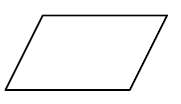 (1)
(1)
6.11.2 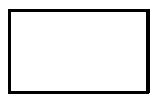 (1)
(1)
6.12 Draw the symbol for a terminator in a flowchart. (1)
6.13 Explain where the symbol in QUESTION 6.11.1 is used in a flowchart. (2)
[50]
TOTAL: 200
FORMULA SHEET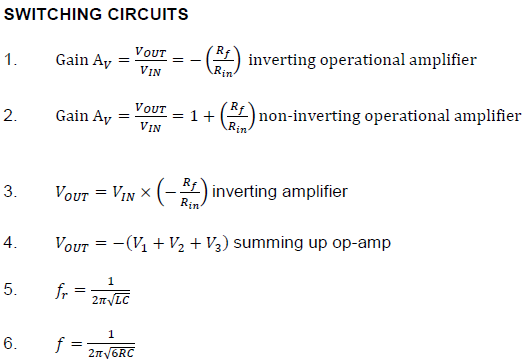
ANSWER SHEET 5.2.1 SEPTEMBER 2021
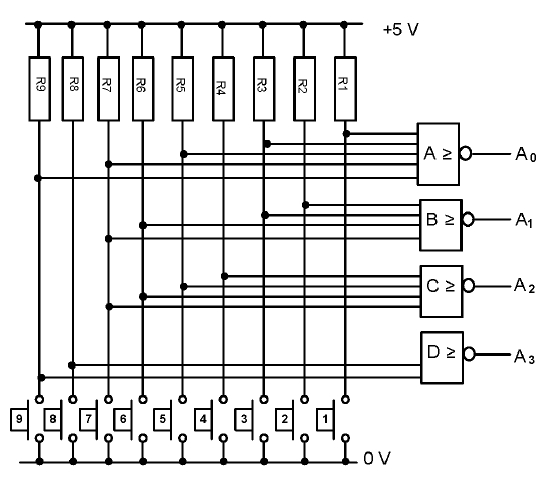
ANSWER SHEET 5.2.2 SEPTEMBER 2021
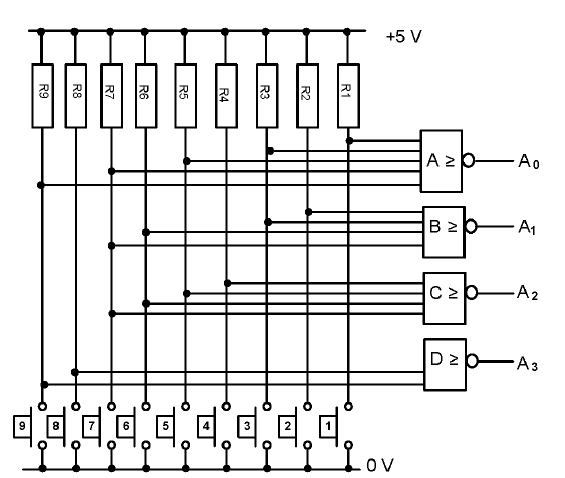
ANSWER SHEET 5.3.2 SEPTEMBER 2021
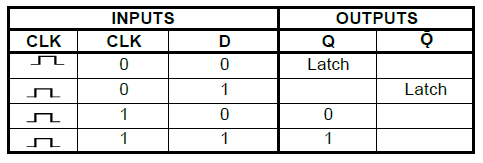
ANSWER SHEET 5.5
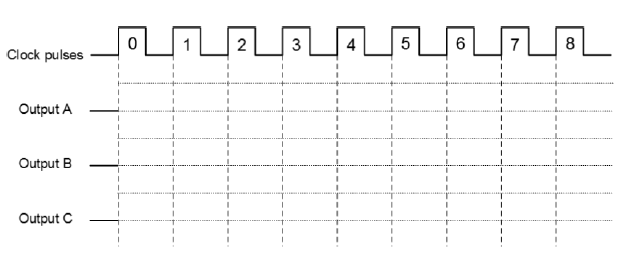
Engineering Graphics and Design Paper 2 Memorandum - Grade 12 September 2021 Preparatory Exams
MEMORANDUM
QUESTION 1: ANALYTICAL (MECHANICAL)
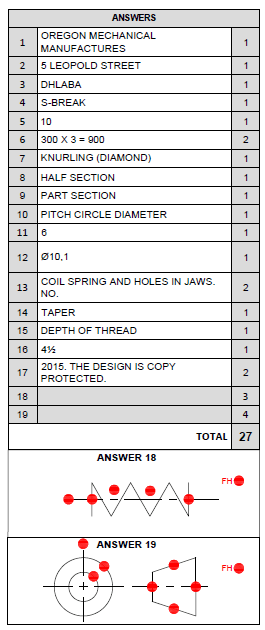
QUESTION 2: 1 LOKUS (CAM)
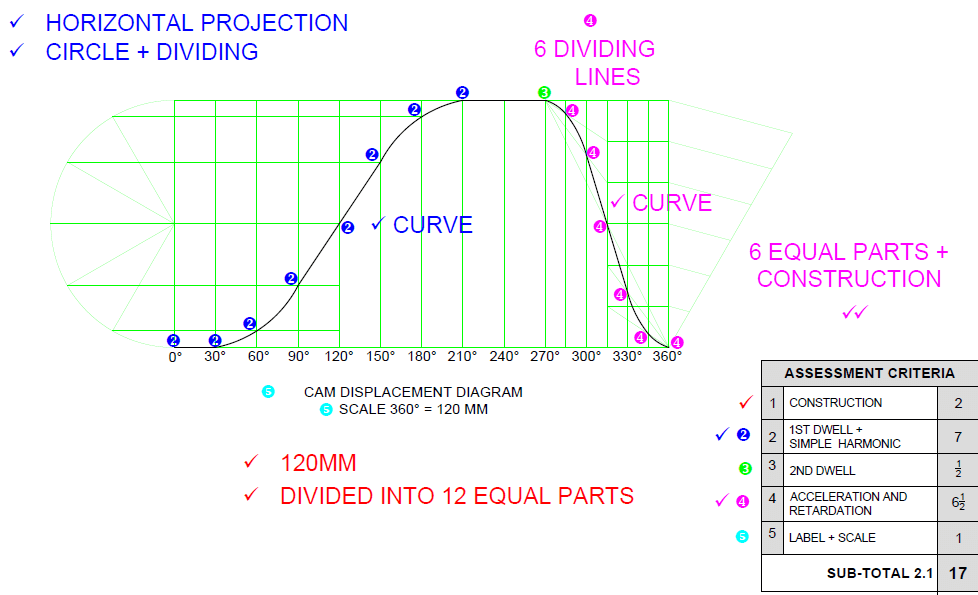
QUESTION 2.2: LOCI (MEGANISMES)
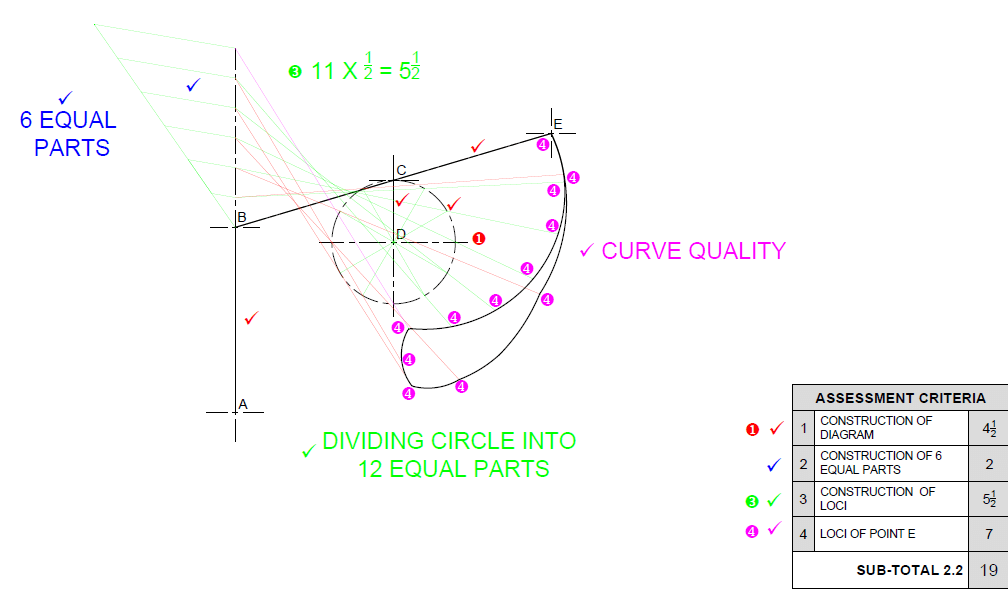
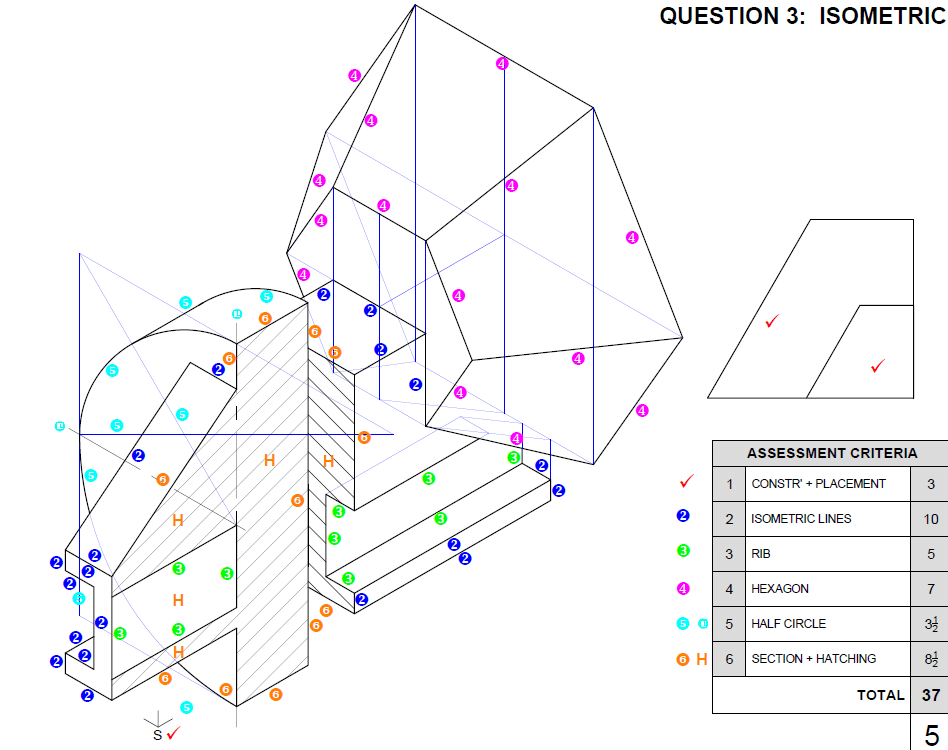
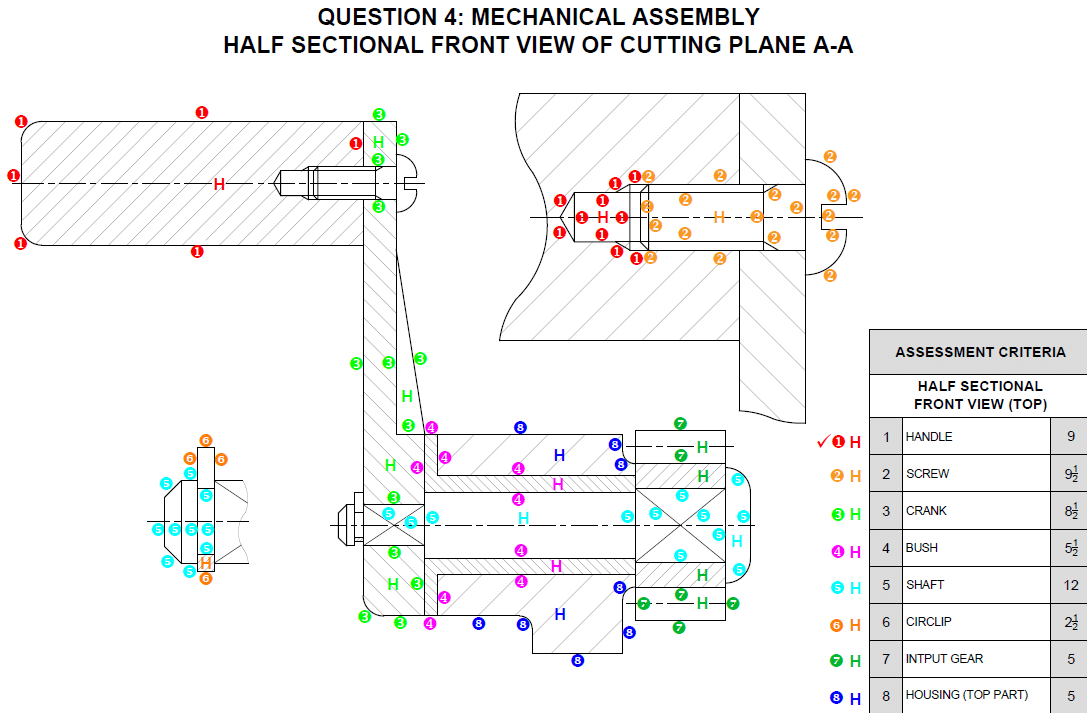
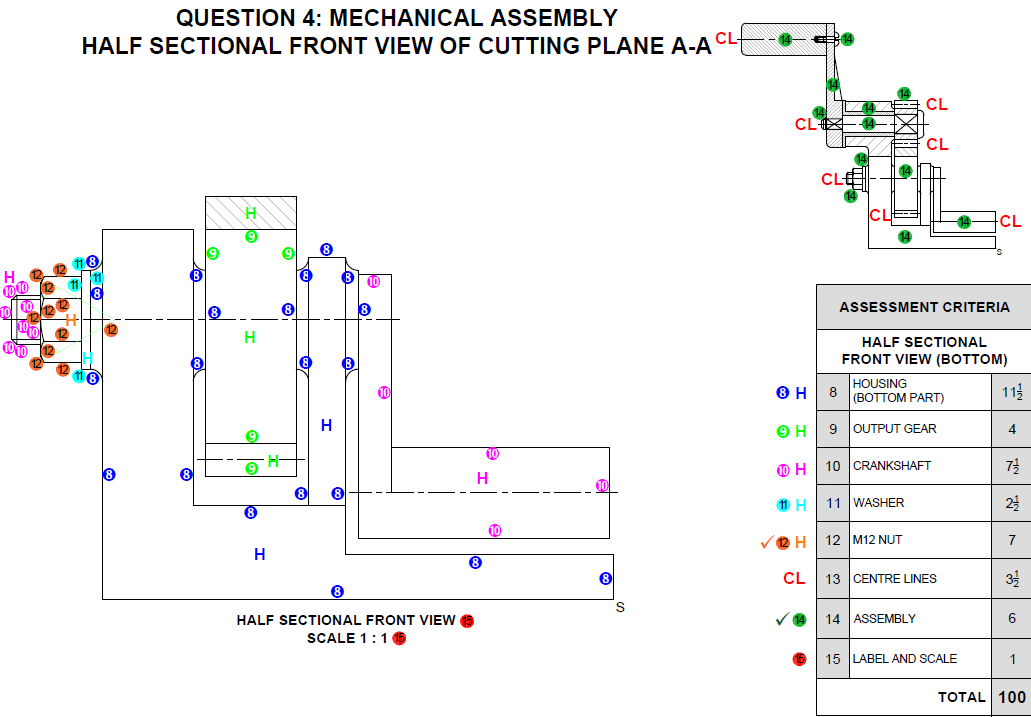
Engineering Graphics and Design Paper 2 Questions - Grade 12 September 2021 Preparatory Exams
QUESTIONS
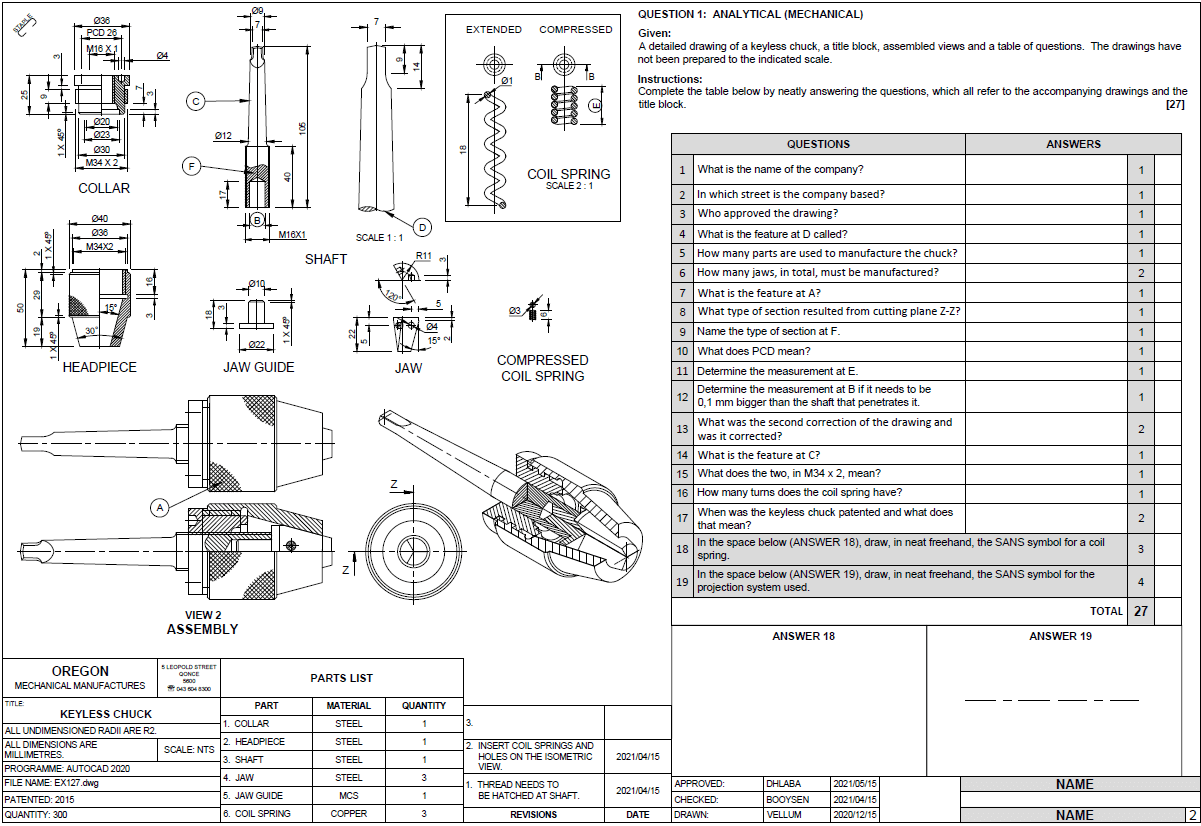
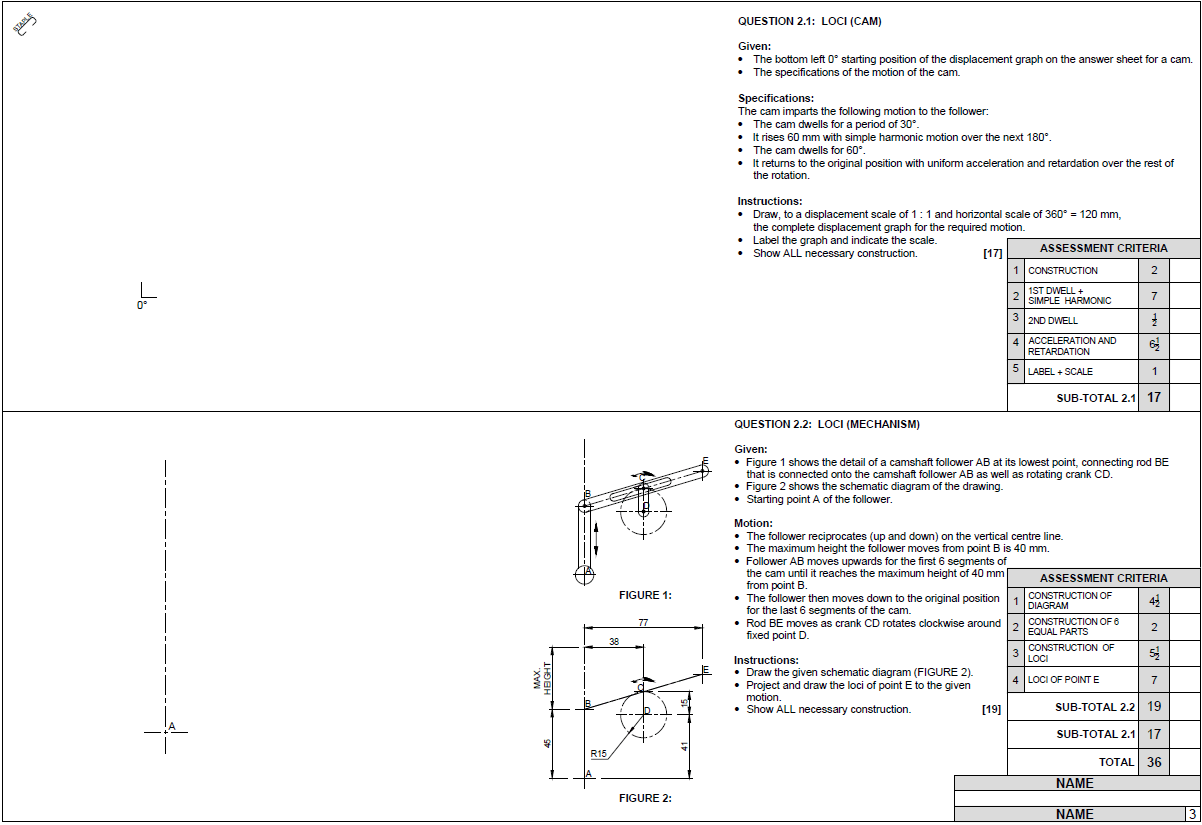
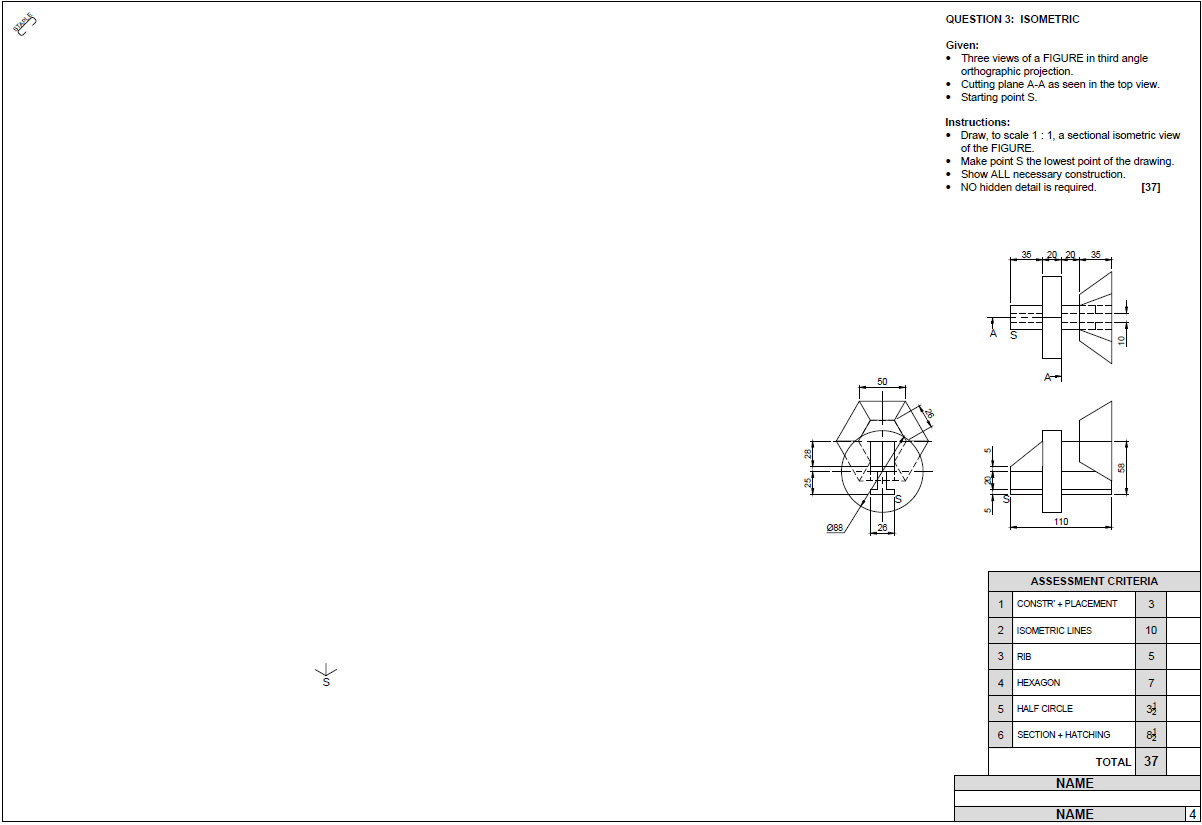
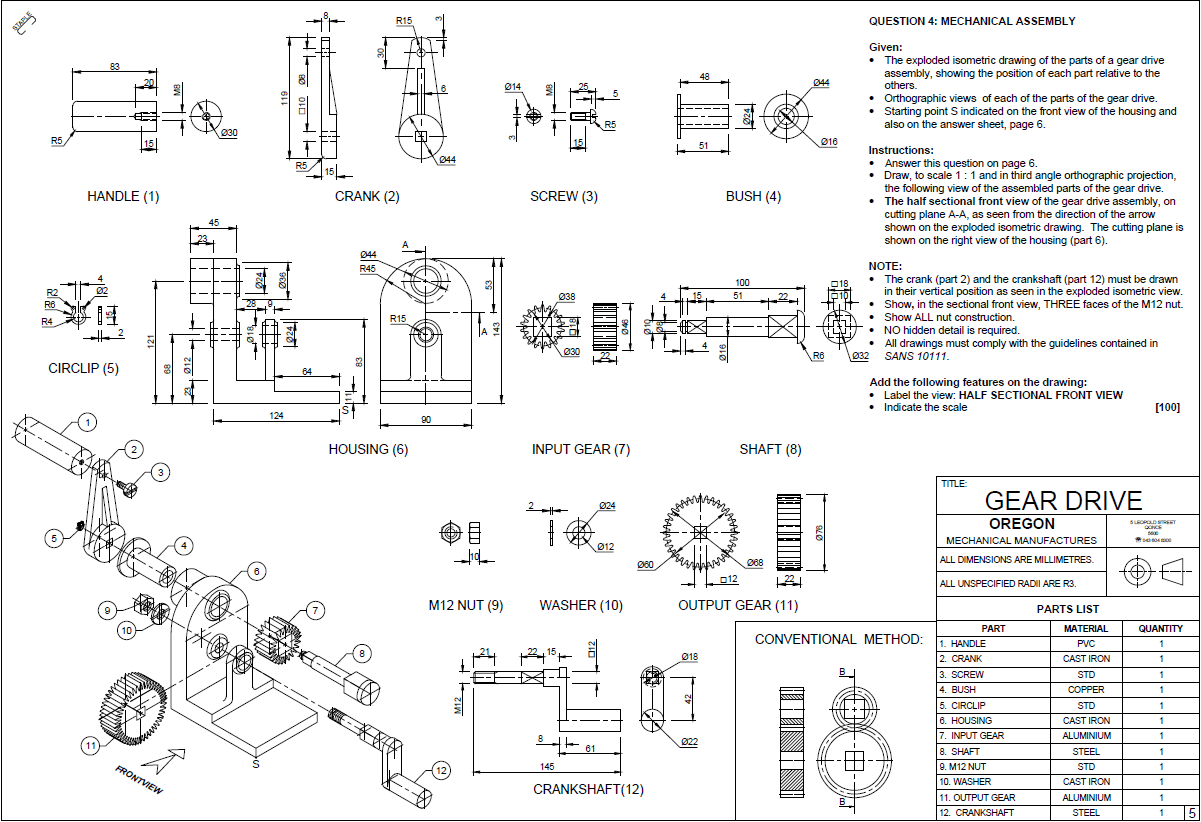
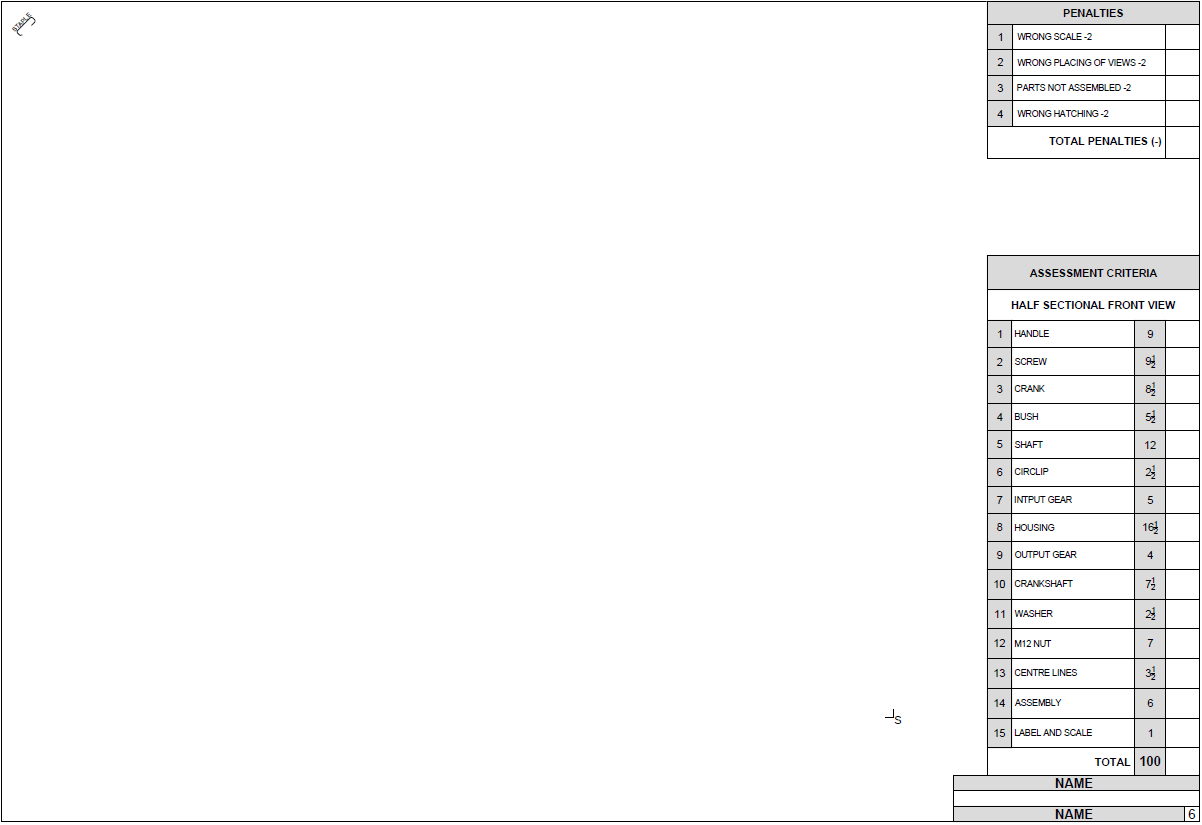
Engineering Graphics and Design Paper 1 Memorandum - Grade 12 September 2021 Preparatory Exams
MEMORANDUM
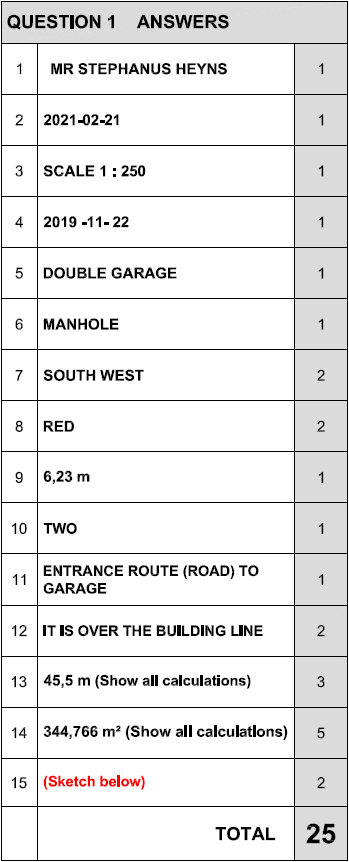

QUESTION 3:INTERPENETRATION AND DEVELOPMENT
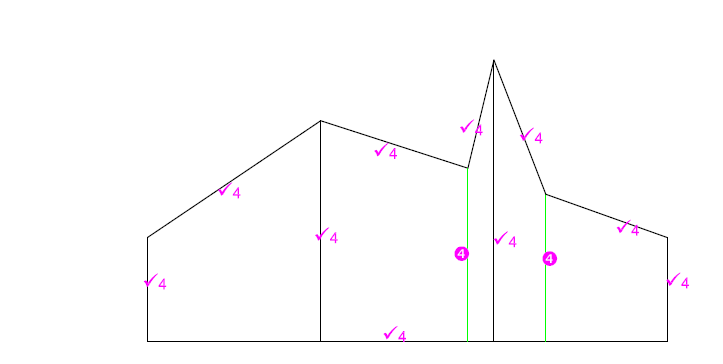
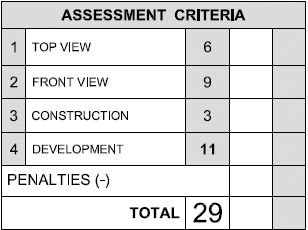
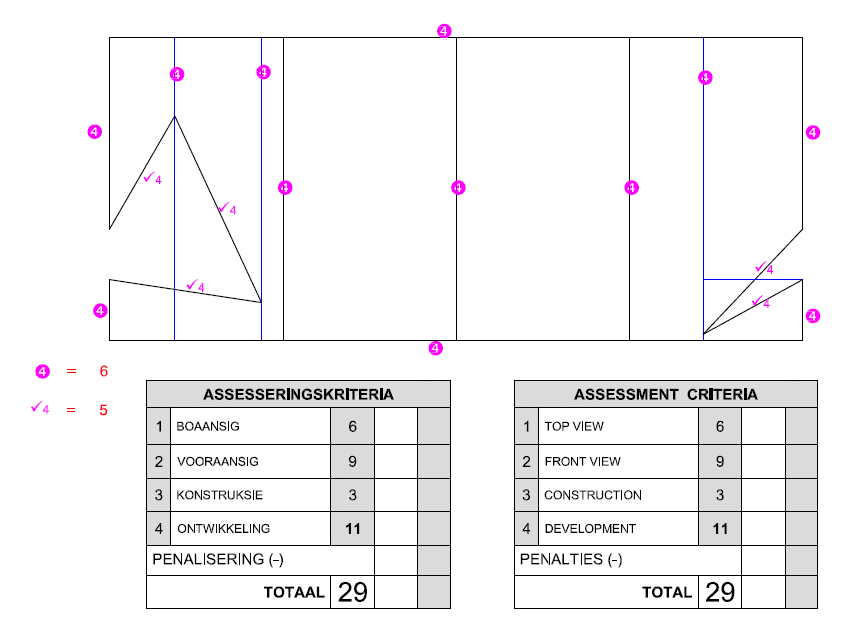
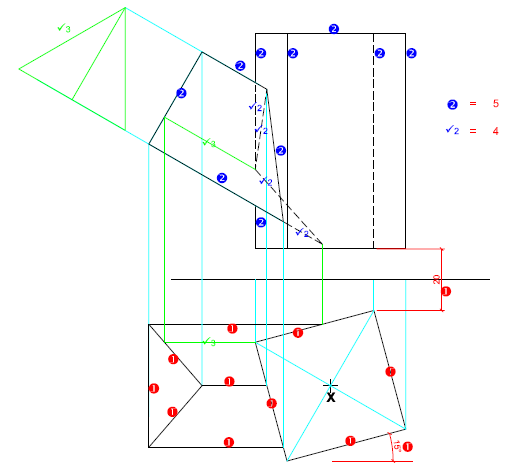
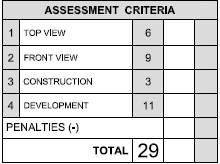
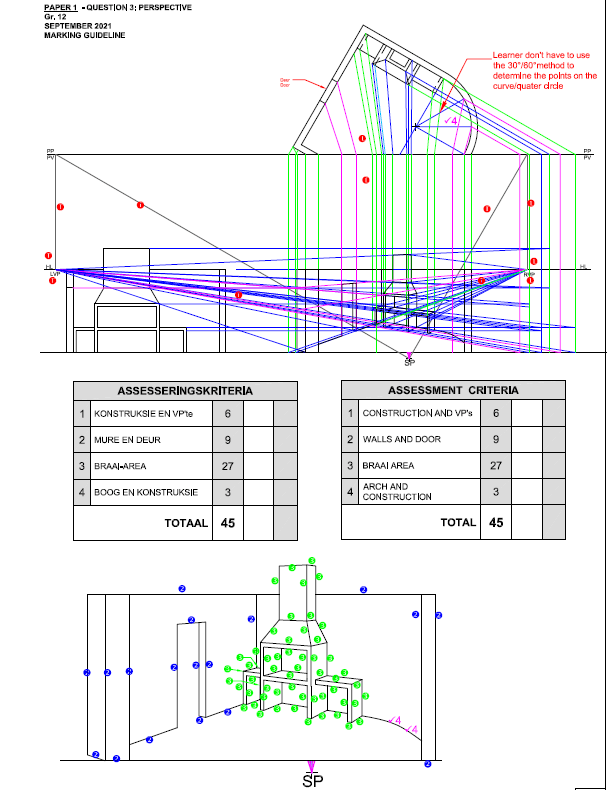
QUESTION 4: FLOOR PLAN
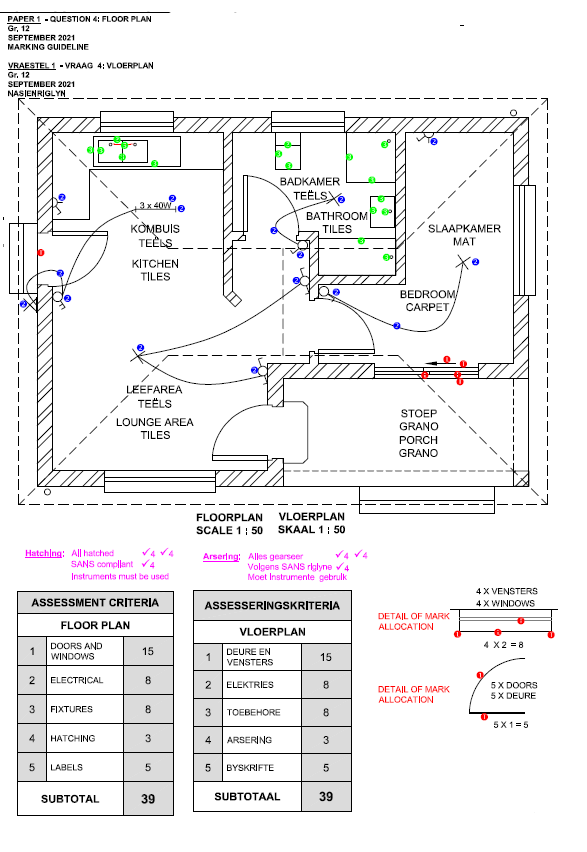
QUESTION 4: ELEVATION
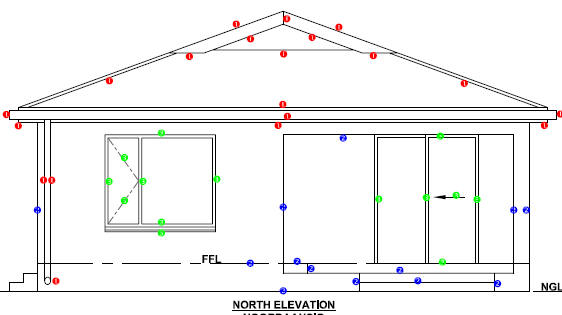
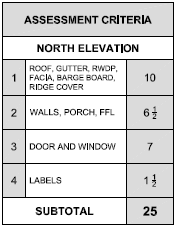
QUESTION 4: SECTION
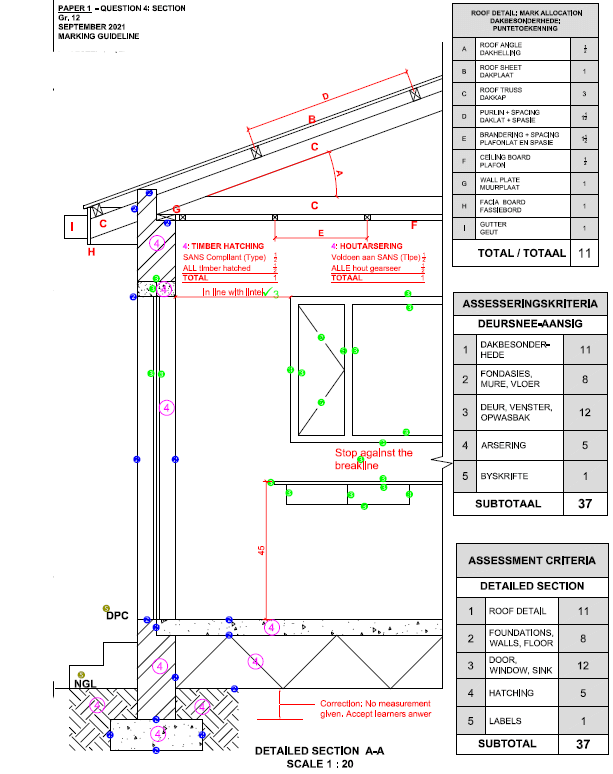
Engineering Graphics and Design Paper 1 Questions - Grade 12 September 2021 Preparatory Exams
QUESTIONS
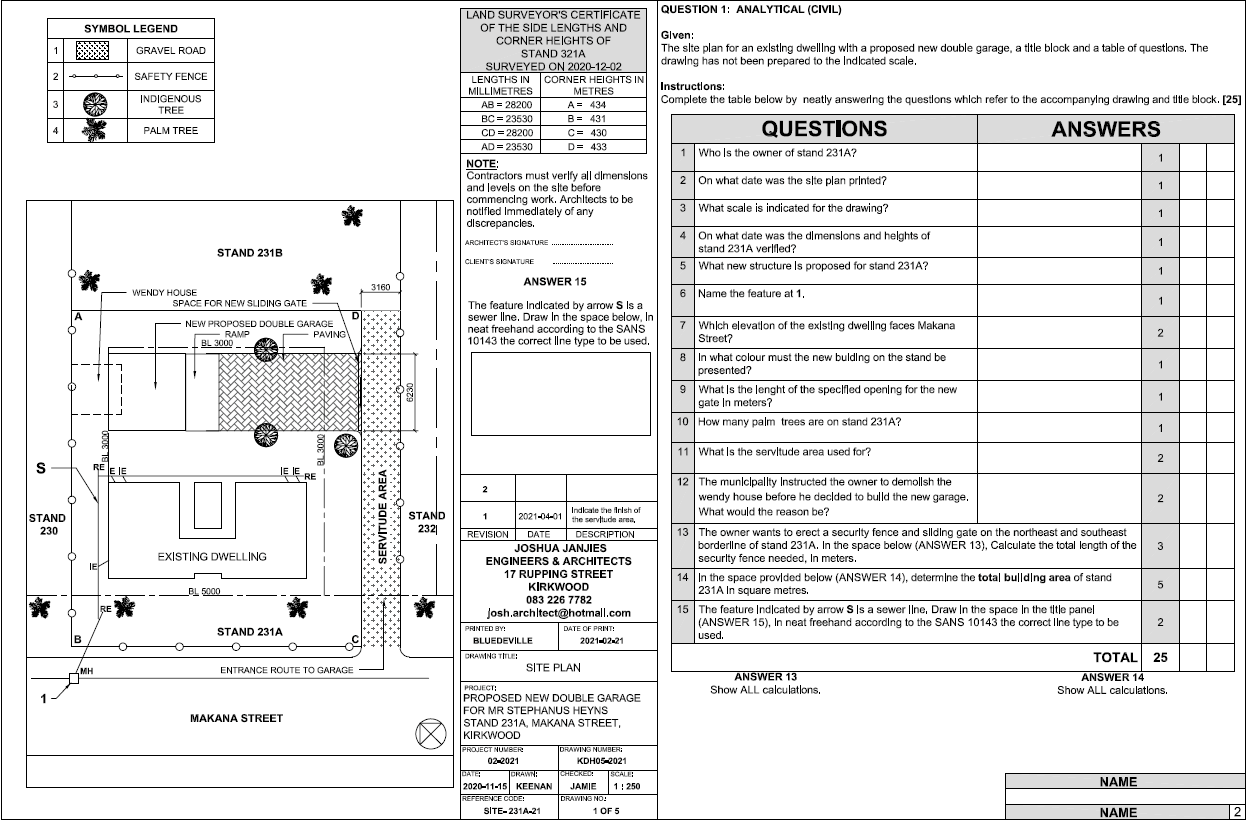

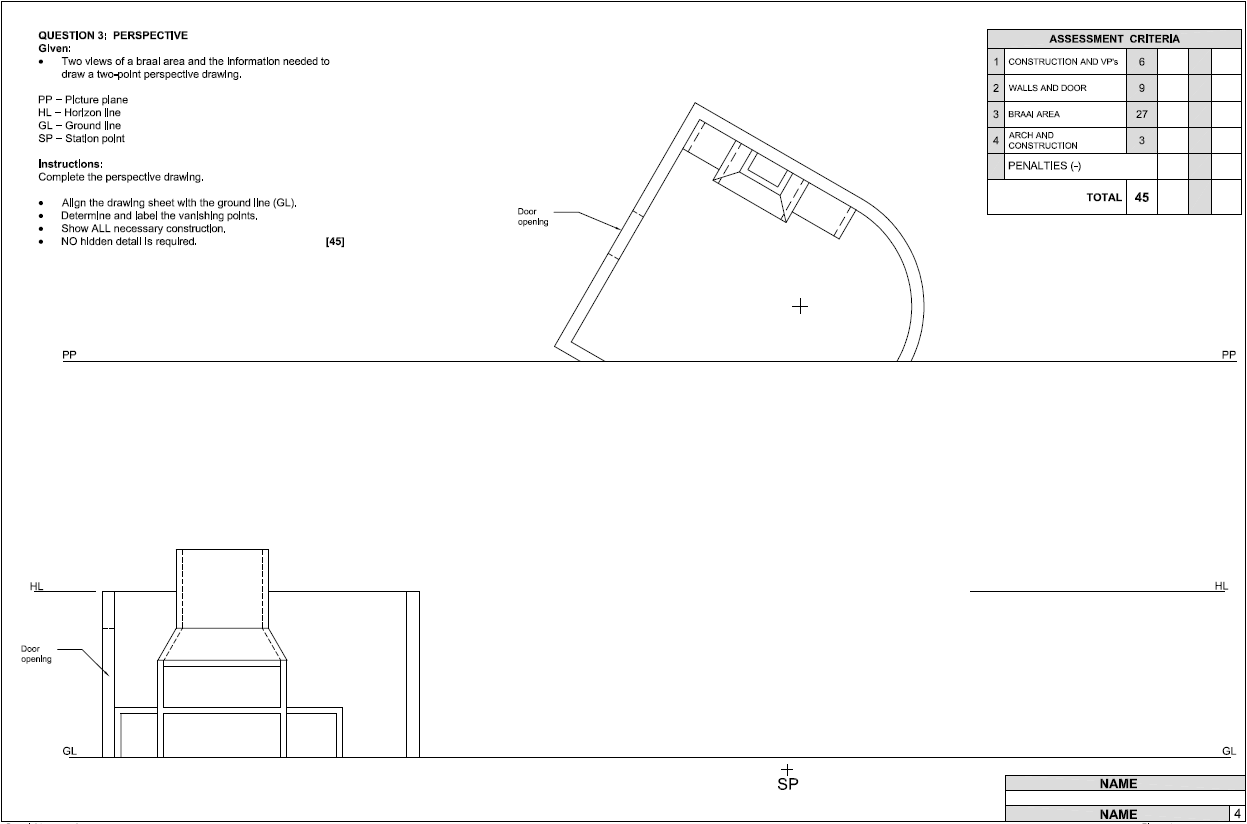
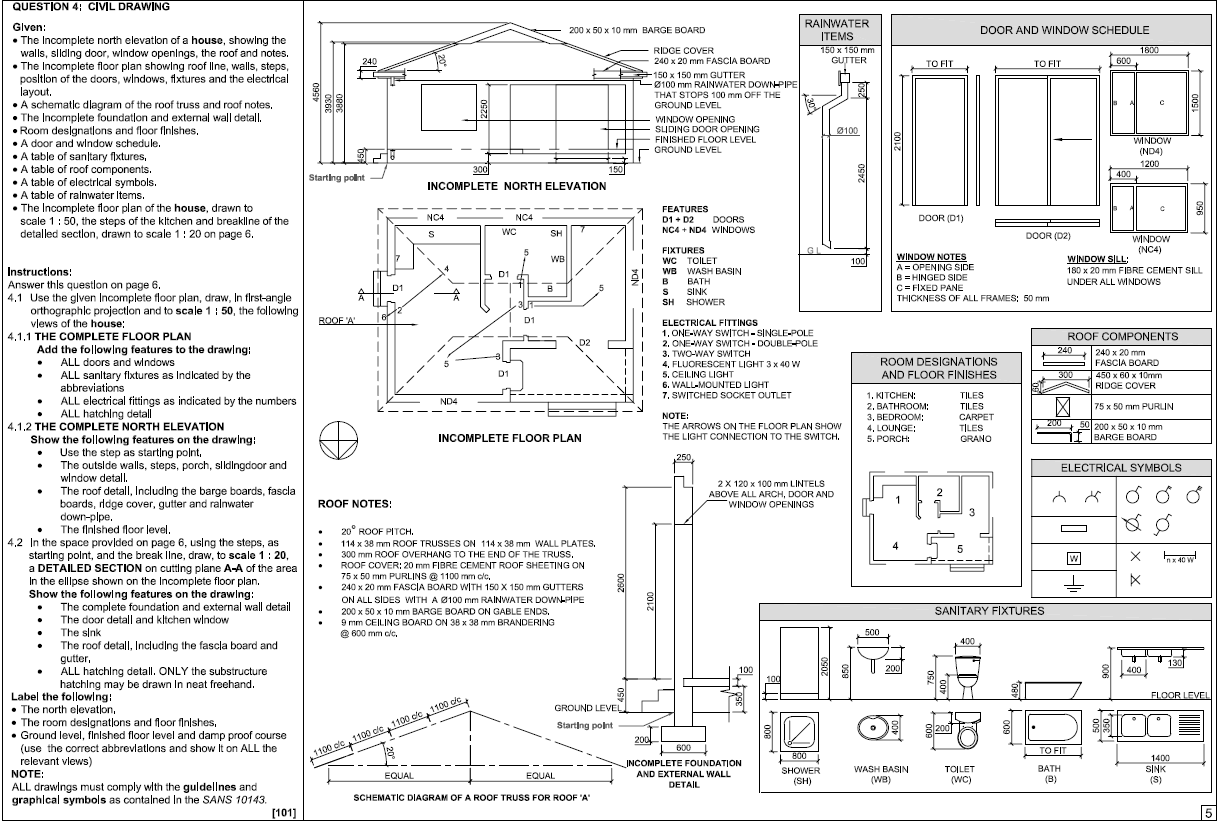
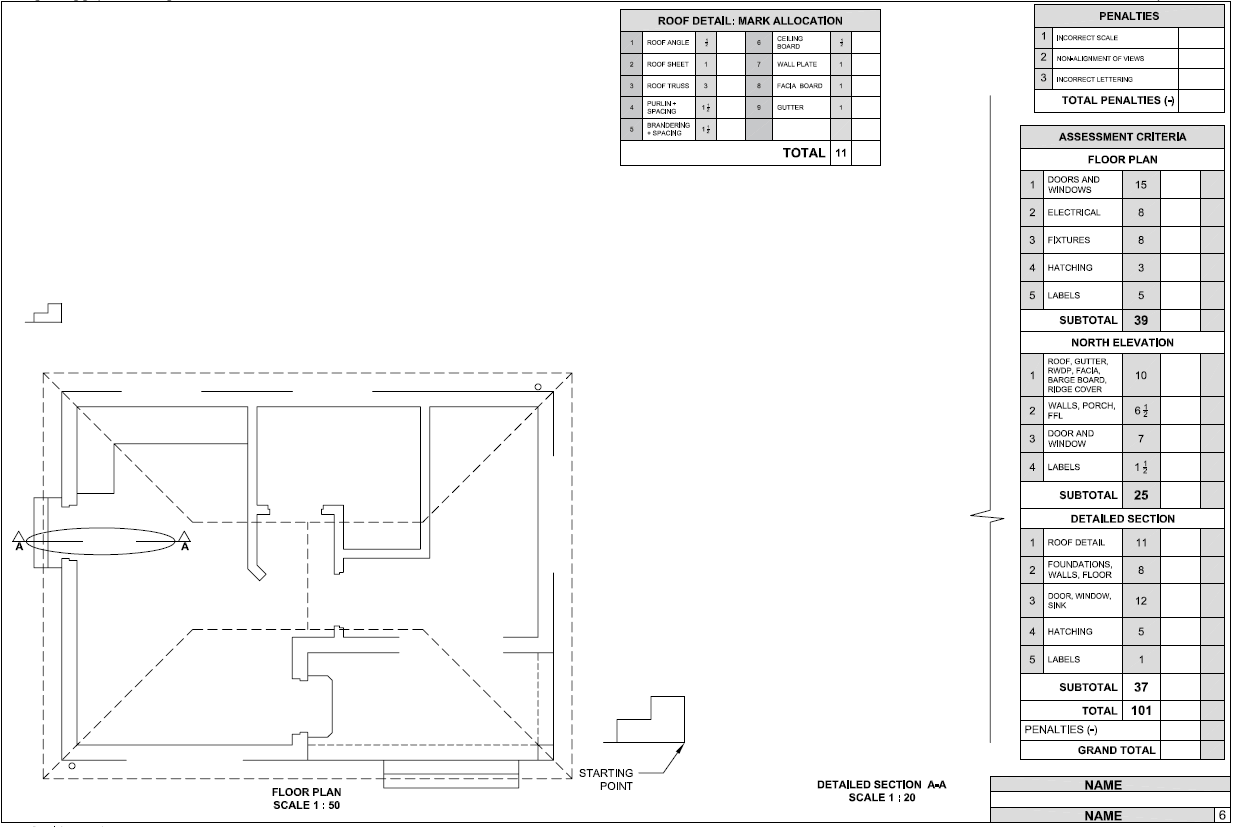
Economics Paper 2 Memorandum - Grade 12 September 2021 Preparatory Exams
MEMORANDUM
SECTION A (COMPULSORY)
QUESTION 1
1.1 MULTIPLE-CHOICE QUESTIONS
1.1.1 B implicit costs
1.1.2 C differentiated
1.1.3 C all factors of production can change
1.1.4 A private
1.1.5 D government spending
1.1.6 A outbound
1.1.7 B renewable
1.1.8 D fiscal (8 x 2) (16)
1.2 MATCHING ITEMS
1.2.1 G No major government influence and control
1.2.2 E Investigates restrictive business practices
1.2.3 D Organisation of businesses that come into existence to form a collective monopoly
1.2.4 I Incurred by businesses when producing goods and services
1.2.5 B Takes into account the effects of inflation on gross domestic product
1.2.6 C Enjoyment and appreciation of undisturbed nature
1.2.7 H Created in production
1.2.8 F Obtained from the use of water, tides, the sun and wind (8 x 1) (8)
1.3 GIVE ONE TERM
1.3.1 Normal profits
1.3.2 Market
1.3.3 Non-rivalry
1.3.4 Stagflation
1.3.5 World Heritage Site
1.3.6 Indigenous Knowledge System (6 x 1) (6)
TOTAL SECTION A: 30
SECTION B
Answer TWO of the three questions from this section in your ANSWER BOOK.
QUESTION 2: MICROECONOMICS
2.1 Answer the following questions.
2.1.1 List any TWO examples of collective goods.
- Parks
- Beach facilities
- Pavements
- Streets
- Roads
- Bridges
- Public transport
- Sewerage systems
- Waste removal
- Refuse removal
(Accept any other relevant correct response) (2)
2.1.2 Why is the demand curve of a perfect competitor horizontal?
The demand curve is horizontal because:
- the firm can sell any amount of goods at the prevailing market price, so even a small increase in price will lead to zero demand
- this indicates that the firm has no control over the price
(Accept any other relevant correct response) (2)
2.2 DATA RESPONSE
2.2.1 Identify the shut-down point from the graph above.
- Point b (1)
2.2.2 Name the curve depicted by letter A.
- Marginal Cost curve/MC (1)
2.2.3 Briefly describe the concept shut-down point.
- Shut-down point is the point where the firm cannot meet its average or total variable costs
- Shut-down occurs when the lowest point of the AVC curve is greater than the market price (AR)
(Accept any other relevant correct response) (2)
2.2.4 Describe the nature of the products in perfect competition.
- Products are homogenous
- They are similar or identical to ensure that no seller can distinguish his product from his competitors which would allow him to charge a higher price
- Products are the same in terms of quality, texture etc.
(Accept any other relevant correct response) (2)
2.2.5 What effect does the entrance of new firms have on the perfect market?
- As new firms enter, the supply curve shifts to the right increasing the quantity supplied in the industry
- Prices of goods fall as well as profits
- As firms continue to enter the industry economic profits fall to zero and only normal profits will be experienced by producers
- Some firms in the industry will experience economic losses, and will leave the industry
- The supply curve shifts to the left, increasing price and reducing losses
(Accept any other relevant correct response) (4)
2.3 DATA RESPONSE
2.3.1 Identify the type of negative externality depicted by the picture above.
- Air pollution (1)
2.3.2 Name any ONE method used by government to reduce negative externalities.
- Carrying campaigns to persuade people from causing externalities
- Levying taxes on goods that cause negative externality
- Passing laws and regulation (1)
2.3.3 Briefly describe the concept negative externality
- Negative externality is a cost to a third party which is not included in a market price of a good/product
(Accept any other relevant correct response) (2)
2.3.4 Explain how demerit goods cause market failure.
- Demerit goods are those goods that are determined to be harmful to society and are over-consumed like cigarettes, alcohol and drugs
- More of the good is produced than is desirable
- The government bans or reduce the consumption of these goods through taxation, and provides information to the population on their harmful effects
(Accept any other relevant correct response) (2)
2.3.5 Why would the government intervene in the operation of markets?
The government intervene in markets because:
- markets may inefficiently allocate resources which may lead to inequities in the economy
- the government would intervene to promote social welfare, for example, breaking up monopolies and regulating negative externalities
- there could be an inequitable distribution of income and wealth which the government needs to correct
(Accept any other correct relevant response) (2 x 2) (4)
2.4 Briefly explain the long run equilibrium position of a monopolist with the aid of a fully labelled graph.
LONG RUN EQUILIBRIUM OF A MONOPOLY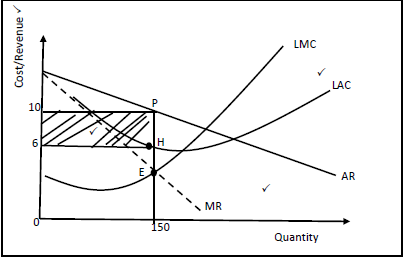
Mark allocation
- Labelling of the axis 1 mark
- Correct position and labelling of revenue curves 1 mark
- Correct position and labelling of cost curves 1 mark
- Correct area of economic profits 1 marks
- Maximum = 4 marks
Explanation:
- In the long run the monopolist makes economic profits
- The LMC curve intersects the LAC curve at its minimum point
- Profit maximisation is at point E where MR=MC, with quantity 150 produced at a price of R10 per quantity, and the average cost is R6
- The monopolist is making a profit of R4 per unit (total economic profit is R600)
- The total economic profit is represented by the shaded area
- The monopolist will produce where the MR=MC
(Accept any other relevant correct response) Max. 4 marks (8)
2.5 Why does the government provide merit goods and services?
The government provides merit goods and services because:
- merit goods are goods and services that are deemed to be socially desirable and therefore the government feels that its consumption should be encouraged.
- there are substantial positive externalities involved in their consumption and if they are left to the market, only private benefits and private costs would be reflected in the price paid by consumers.
- they are likely to be under-produced and under-consumed through the market mechanism and social welfare will not be maximised
- imperfect information about merit goods may lead to individuals not acting in their best interest
- equity considerations demand that merit goods such as education and health be provided on the basis of need rather than on the basis of the individual’s ability to pay
- for example, the market is unlikely to provide the optimal quantity of health care when consumers actually need it, because they may be short of the necessary finance to pay the market price.
(Accept any other correct relevant response) (4 x 2) (8)
[40]
QUESTION 3: CONTEMPORARY ECONOMIC ISSUES
3.1
3.1.1 List any TWO approaches to devising command and control
- Quantity standards
- Quality standards
- Social impact standards
(Accept any other relevant correct response) (2)
3.1.2 What is the impact of COVID 19 on foreign tourists into South Africa?
- There has been a decline in international tourists of about 40% to 6,1 million for the year due to COVID 19 restrictions on inter- cross border travels
- Flights to South Africa had been suspended and that led to “O” based arrivals between April and September 2020
(Accept any other relevant correct response) (2)
3.2 DATA RESPONSE
3.2.1 Identify, from the extract, the most emitted greenhouse gas in South Africa
- Carbon dioxide (CO2) (1)
3.2.2 State the industry that contributes most to global warming.
- Energy industry (1)
3.2.3 Briefly describe the concept renewable resources.
- Renewable resources are the resources that are able to reproduce themselves and can be used again and again
(Accept any other relevant correct response) (2)
3.2.4 Explain voluntary agreements as means by the government to sustain the environment.
- The government concludes agreements with businesses on voluntary basis to cut pollution
- The government seeks to enter into voluntary agreements rather than posing laws and regulations with businesses
- Such agreements may involve a formal contract which would be legally binding
- Businesses prefer voluntary agreements than regulations because they can negotiate such agreements to suit their own particular circumstances and build them into their planning
(Accept any other correct relevant response) (2)
3.2.5 How would consumers contribute in reducing climate change?
Consumers would contribute by:
- Investing in energy efficient appliances to promote green economy and green technology
- using solar panels or a wind turbine, for a clean-energy
- economy
- using public transport / driving a fuel-efficient vehicle so as to reduce carbon dioxide emissions
(Accept any other relevant correct response) (4)
3.3 DATA RESPONSE
3.3.1 Name ONE marketing campaign that has contributed in growth in domestic tourism.
- Shot’ left
(Accept any other relevant correct response). (1)
3.3.2 State any ONE World Heritage attraction in South Africa.
- Kruger National Park
- Robben Island
- Isimangaliso Wetland Park
- Table Mountain
(Accept any other relevant correct response) (1)
3.3.3 Briefly describe the concept domestic tourism.
- Domestic tourism is traveling by the residents within the borders of the country
(Accept any other relevant correct response) (2)
3.3.4 Explain the negative effects of tourism on the local community.
- Tourism can lead to increased inequalities between groups in the country because rural people do not always benefit fully from it
- Less educated people seldom experience benefits of tourism
- Local prices can increase because tourists often pay more for goods and services which is often beyond what the locals can afford
- High levels of tourism can lead to traffic congestion, pollution, litter, crime, increased carbon dioxide emissions etc.
(Accept any other relevant correct response) (2)
3.3.5 How does tourism differ from other service industries?
Tourism differs from other service industries in that:
- Tourism can impact positively and negatively on indigenous community
- Some inputs of tourism often involve non-price elements such as viewing scenic beauty, a stroll on the beach which is not the case with other service industries
- Tourism is a very broad and complex concept which is a combination of several industries because it includes a range of services and service providers like travel agencies, tour operators, taxi and shuttle services etc.
(Accept any other relevant correct response) (4)
3.4 Explain the Kyoto Protocol as a major international protocol and agreement on sustainable development.
- Kyoto Protocol is an international agreement between countries around the globe to reduce emission of greenhouse gases
- It came into force in 2005 and was first open for signature to countries to participate in 1997
- Kyoto Protocol established legally binding obligations whereby industrialised countries agreed to reduce their emissions of six greenhouse gases
- It only binds developed countries because it recognises that they are largely responsible for the current high levels of GHG emissions in the atmosphere
- Each industrialised country was given a specific target of about 5.2% to reduce its emissions
- If they are unable to do so they must purchase emission credits from countries that are below those levels
- The protocol established a monitoring, review and verification system as well as a compliance system to ensure transparency and hold parties accountable
(Accept any other relevant correct response) (8)
3.5 Examine the negative effects of globalisation on environmental sustainability.
Globalisation negatively affects environmental sustainability because:
- Globalisation increases global consumer demand leading to an increase in production Increased production puts pressure on the environment and the faster depletion of natural resources.
- The increased economic activity leads to greater emissions of industrial pollutants and more environmental degradation.
- The pressure on international firms to remain competitive forces them to adopt cost-saving production techniques that can be environmentally harmful.
- The industrial waste, usually harmful chemicals, that is generated as a result of production has been dumped in oceans and that killed many underwater organisms
- Globalisation has also led to an increase in the transportation of raw materials and food from one place to another. The amount of fuel that is consumed in transporting these products has led to an increase in the pollution levels in the environment.
- Due to globalisation and industrialisation, various chemicals are being thrown into the soil which then results into the growth of many noxious weeds and plants.
- This toxic waste causes a lot of damage to plants by interfering in their genetic makeup and put pressure on the available land resources. (Accept any other relevant correct response) (8)
[40]
QUESTION 4: MICROECONOMICS AND CONTEMPORARY ECONOMIC ISSUES
4.1
4.1.1 Name any TWO criteria that an activity must satisfy to be a tourism activity.
- There must be a purpose for the visit
- No remuneration must be earned
- Minimum length of stay of one night
- Maximum length of stay of one year
- Travelling distance of more than 160 km (2)
4.1.2 What would happen if one firm in a perfect market decides to increase its selling price?
- The firm will lose customers as homogenous products are sold
- Lesser profits will be made by the firm (2)
4.2 DATA RESPONSE
4.2.1 Identify the sector that contributed the least in GDP in 2017.
- Agriculture (1)
4.2.2 What was the total contribution of tourism to GDP in 2017?
- 2,8% (1)
4.2.3 Briefly describe the concept manufacturing.
- Manufacturing is the process of transforming raw material into finished goods.
(Accept any relevant correct description) (2)
4.2.4 Explain how creative representative bodies distribute tourists effectively to tourist sites.
- Creative representative bodies are formed by tourist-based industries then tourists easily access knowledge about all tourist destinations. (2)
4.2.5 How does tourism contribute in boosting the economy?
Tourism contribute in boosting the economy by:
- Creating thousands of jobs in many different areas
- Improving the revenue of the country through spending and taxes paid by tourists
- Allowing young entrepreneurs to establish new products and services that would not be sustainable on the local population alone
- Planting a sense of cultural exchange between foreigners and residents through exhibitions, events etc. which will attract more tourists into the country
(Accept any other relevant correct response) (4)
4.3 DATA RESPONSE
4.3.1 Identify from the graph above the optimum output level.
- 4 units (1)
4.3.2 At which point from the graph above will the firm break-even?
- Point A (1)
4.3.3 Briefly explain the concept total cost.
- Total costs are all the costs incurred by a business enterprise/the costs or remuneration for all the factors of production used in the production process
(Accept any other relevant correct response) (2)
4.3.4 Describe the marginal revenue curve (MR) of a monopoly.
- Monopoly faces a downward sloping marginal revenue curve that is lower than the price, therefore it lies below the average revenue (AR)
- It lies below the AR curve because each additional unit the firm sells brings in less revenue than the previous units sold (Accept any other relevant response) (2)
4.3.5 What is the significance of the South African Competition Act?
Competition Act is important in that:
- It promotes and maintain competition in order to achieve the objectives of promoting efficiency in markets, adaptability and development of the economy
- Through competition, consumers will be provided with competitive prices
- Employment will be promoted and there will be advancement of the social economic welfare
(Accept any other relevant correct response) (4)
4.4 Briefly explain the effects of tourism on employment and poverty.
Employment
- Tourism is the world generator of jobs because it is labour intensive with the lowest ratio of investment in employment creation
- Directly and indirectly more than 9% of South Africans are employed in the tourism industry
- A wide range of skills is required in the tourism industry, from accountants and hairdressers to tour guides and trackers – this makes it easier for a variety of people to find employment
- Tourism provides entrepreneurial opportunities by accommodating informal sector enterprises, from craft and fruit vendors to pavement vendors, chair rentals and so forth
Poverty
- Tourism offers opportunities to diversify sources of income for poor people by allowing them a stake, for example, to start and operate small scale tourism businesses around community assets
- People are able to earn an income in their home areas resulting in a reduction in urbanisation and a more balanced population distribution
- Tourism development in rural areas increases the number of available jobs in areas where there are not many jobs
- The income that the tourism industry generates contributes to the country’s economic growth and development which is essential for improving the standard of living and alleviating poverty (Accept any other relevant correct response) (8)
4.5 Examine the effects of setting a maximum price on petrol in South Africa.
- Maximum price is set below the on-going market price to make goods more affordable
- In South Africa, the petrol price is controlled by the government at the maximum price
- The government intervenes and pass laws that suppliers may not charge more than the maximum price
- Setting the maximum price on petrol will make production costs more reasonable for producers which will be passed on to consumers
- The poor will have greater access to certain goods produced with using petroleum
- With affordable prices of petrol, the welfare of some consumers will be improved since goods will be produced and consumed at affordable prices
- Businesses will be able to increase their production thus creating employment in the economy and making more profits (Accept any other relevant correct response) (8)
TOTAL SECTION B: 80
SECTION C
QUESTION 5 MICROECONOMICS
- Discuss in detail, without the use of graphs, the characteristics of an oligopoly. (26 marks)
- Examine the negative impact of oligopolists behaviour on consumers. (10 marks)
INTRODUCTION
Oligopoly is a market structure in which a small number of large sellers dominate the market. An oligopoly exists when a small number of large companies are able to influence the supply of a product or service.
(Accept any other relevant correct response) (2)
MAIN PART
Number of businesses
- The market consists of few firms that dominate the market e.g. banks
- Each firm is aware of the actions of the others in the market and this has an impact on decision-making
- This means each producer not only influences others but he also has to consider them
- If there is two firms in the market, it is called a duopoly
Nature of the product
- Products sold may be homogeneous or heterogeneous
- When product are homogenous, the market is called a pure oligopoly e.g. petrol
- When products are different, the market is referred to as a differentiated oligopoly e.g. motor cars
Entry into the market
- It is difficult to enter the market due to various barriers
- A large amount of capital is usually required to enter the market
- It is often difficult to overcome barriers imposed by consumer preferences brands
- Firms usually spend a lot of money on advertising to create brand loyalty
- The existing firms may often be enjoying economies of scale and this may be a further barrier
Control over price
- Oligopolists have influenced the price but not as much as the monopolists do
- Price wars is often a feature when the existing firms want to limit entrance in the market
Demand curve of the oligopoly
- An oligopoly faces a kinked demand curve. This demand curve consists of two sections
- The top section that relates to high prices has a very elastic slope (i.e. demand is very sensitive to a price change)
- The bottom section that relates to lower prices is very inelastic (i.e. demand is not sensitive to a price change)
Collusion
- Firms often co-operate instead of competing with one another
- This may be by forming cartels (explicit collusion), which are formal agreements for firms to work together
- At times collusion can be in the form of price leadership, which is an unspoken agreement among firms
- Price leadership (tacit/implicit collusion) involves one firm serving as a price leader while others follow
- When the price leader changes its price the other do the same
- Collusion is illegal in South Africa, may not negotiate agreements that can limit competition. Behaviour is liable to large fines by the Competition Commission
Market information
- Buyers and sellers have incomplete information about market conditions
- Even though the oligopolists monitor one another’s actions, they do not always know how the competitor will react to their actions
Price and profits
- Prices are higher in general than under perfect competition
- Oligopolists develop brand loyalty among consumers to generate economic profit
Mutual dependence
- Any decision and actions of one will have a direct effect on the profits of the others who will retaliate by changing prices and output
- In an oligopoly, a firm not only considers the market demand for its product, but also the reactions of other firms in the industry
- No firm can ignore the possible reaction of other firms to its price and output policies
- Firms are forced to change strategy in order to keep up with the manoeuvres of the competition
- In an oligopolistic industry it is difficult to keep secrets because firms watch each other very closely
- Mutual dependence makes policy decisions of businesses in an oligopoly market to be more complex than other market structures
(Allocate a maximum of 8 marks for mere listing of facts /examples)
(Accept any other relevant correct higher order response) (Max. 26)
ADDITIONAL PART
Negative impact:
- Through collusion by firms, consumers may end up paying higher prices
- They will have to spend more to purchase products which should have been in lower prices
- High concentration of businesses reduces consumer choice
- Cartel like behaviour reduces competition and can lead to higher prices and reduced output which may limit a variety of goods for the consumer
- Given lack of competition, producers may be free to engage in the manipulation of consumer decision making
- Oligopolies may lead to a potential loss of economic welfare
(Accept any other relevant correct higher order response) (Max. 10)
CONCLUSION
Oligopolies play a very important role in the economy as most of the manufacturing industries in south Africa are oligopolistic in nature and produce the largest portion of the total output and worldwide, they are the common market structure of the modern economies
(Accept any other relevant correct high order conclusion.) (2)
[40]
QUESTION 6: CONTEMPORARY ECONOMIC ISSUES
- Examine in detail the consequences of inflation (26 marks)
- Why is high inflation rate a concern for business performance? (10 marks)
INTRODUCTION
The influence of inflation in the economy is not always obvious as it does not affect everyone in the same way
The effects of inflation may not be noticeable in the short term but may be very harmful in the long term
(Accept any correct relevant introduction) (2)
MAIN PART
Debtors and creditors
- During periods of rising prices, debtors gain in real terms because the contract was signed in advance and cannot be changed
- Debtors receive the money with a relatively high purchasing power and repay their loans with low purchasing power, unless interest rates are sufficient to prevent the situation
- Inflation harm creditors as they lose due to a fall in the real value of money
- Changes in price levels affect debtors and creditors differently at different time periods
Wage and salary earners
- Real wages fall sharply during periods of high inflation as a result of a decline in capital stock and a shift in relative prices
- Inflation can impoverish large segments of the population by eroding the real wages
- Relative wages are the important component of wealth, they constitute the main source of income for many households, especially for the less well-off
- The behaviour of real wages therefore has a direct bearing on income distribution and the level of poverty
- Wage earners suffer during inflation, despite the fact that they obtain a wage rise to counter the rise in the cost of living, because wages do not rise as much as the rise in prices of those commodities which workers consume
- Inflation most negatively affects those people who earn an income that grows more slowly than the general increase in the prices of goods, e.g. pensioners and those dependent on fixed income such as rentals
- Most pensions are paid a fixed amount that is often determined months or years in advance
- If no provision has been made for inflation, and with the erosion of spending power, they will eventually earn too little to survive
Investors and savers
- People who invest in negotiable instruments such as shares, often benefit from inflation, because during periods of inflation, interest rates are increased to encourage savings
- Investors in assets with flexible market value (e.g. shares and fixed property) usually gain from price increases because the nominal values of these assets tend to increase at least proportionally more rapidly than increases in general price levels in the case of inflation wealth is created to the advantage of those holding such assets
- Investment in assets with fixed nominal value will give a fixed return if assets are held until maturity because their nominal values remain constant and will decrease as prices increase thus reducing their real value
- People save money for long periods with the aim of using these funds to meet future expectations, these savings may be invested as fixed deposits, in the money market, as life policies or in pension funds
- Inflation leads to a decrease in the value of money which means long term savings lose their real value
Tax payers
- With higher inflation, tax payer’s nominal income rise when their real income remain unchanged because taxes are levied on the nominal income but not on real income, and this affects the purchasing power of tax payer
- If the income tax schedule remains unchanged, inflation will increase the average rate of personal income tax
- Individuals will have to pay higher taxes even if they are actually no better off than before
- This means that marginal and average tax rates increase in harmony with the income levels
- The phenomenon, known as a bracket creep leads to a redistribution of income from tax payers to the government
Industrial peace
- Wage bargaining is often accompanied by strikes and mass actions
- These actions can sometimes spill over into violence which affects society at large
- In extreme situations, in the presence of exceptionally high inflation together with a government that is determined not to yield to wage increase demands (which can push inflation to even higher levels) widespread civil unrest would follow
Balance of payments problems
- Inflation has an adverse effect on a country’s balance of payments
- Inflation makes domestic prices to increase and this makes domestic exports uncompetitive on the international markets and South African exporters may lose major trading partners
- The high prices of exports will discourage foreign businesses from buying South African goods resulting in decrease in exports and a loss of foreign exchange earnings
Psychological influence
- Inflation impacts negatively on economic growth
- Inflation creates a negative sentiment
- This means that there is an unfavourable psychological climate for economic activities and people are so uncertain about future prices and values
Poverty levels and unemployment
- Increase in prices of basic food and services affect the poor the most as a result poverty levels increase
- Social grants have to increase at the inflation rate, which is costly to taxpayers
- Employers often react to increasing costs by dismissing low-paid employees
(Allocate a maximum of 8 marks for examples/mere listing of facts)
(Accept any other relevant correct response) (Max. 26)
ADDITIONAL PART
High inflation rate is a concern for business performance because:
- Rising costs for businesses could result in larger production spending on inputs and falling profitability
- Businesses will therefore be forced to increase the prices to supplement the high costs
- For this they will receive a negative response from consumers which will affect the level of production and will end up selling fewer quantities
- Expectation of high inflation and feeling of uncertainty will result from the consumer overspending, and money hoarding in a time of inflation, thus affecting the profits of businesses when inflation rise
- Consumers may hold back on spending until they enter a safer economic climate, again lowering business profits
- With consumers holding back on spending, businesses can unfortunately feel the brunt of this with a potential reduction of sales
- The effect of inflation can be detrimental to business stability, disrupt business planning and lead to lower investment
- If costs are rising due to inflation, producers may not be able to pass them to consumers
(Accept any other relevant correct higher order response) (Max. 10)
CONCLUSION
It is important for the government to take specific actions to keep inflation under
control as high inflation rates can have serious social, economic and political consequences
As an economic measure, inflation inform people how well the stability of prices is achieved so that they plan well for the future
(Accept any other relevant correct higher order response) (2)
[40]
TOTAL SECTION C: 40
GRAND TOTAL: 150
Economics Paper 2 Questions - Grade 12 September 2021 Preparatory Exams
INSTRUCTIONS AND INFORMATION
- Answer FOUR questions as follows in the ANSWER BOOK:
- SECTION A: COMPULSORY
- SECTION B: Answer TWO of the three questions.
- SECTION C: Answer ONE of the two questions.
- Number the answers correctly according to the numbering system used in this question paper.
- Write the number of the question above each answer.
- Read the questions carefully.
- Leave 2–3 lines between subsections of questions.
- Answer the questions in full sentences and ensure that the format, content and context of your responses comply with the cognitive requirements of the questions.
- Answer only the required number of questions. Answers in excess of the required number will NOT be marked.
- Use only black or blue ink.
- You may use a non-programmable pocket calculator.
- Start EACH question on a NEW page.
- Write neatly and legibly.
QUESTIONS
SECTION A (COMPULSORY)
QUESTION 1 30 MARKS – 20 MINUTES
1.1 Various options are provided as possible answers to the following questions. Choose the answer and write only the letter (A–D) next to the questions numbers (1.1.1 to 1.1.8) in the ANSWER BOOK, for example 1.1.9 D.
1.1.1 The value of the inputs that are owned by the entrepreneur and used in the production process are called … costs.
- total
- implicit
- explicit
- marginal
1.1.2 Products produced by monopolistic competitive firms are …
- unique.
- homogeneous.
- differentiated.
- the same.
1.1.3 In economics, the long run refers to the time period where …
- all the factors of production are fixed
- some factors of production are fixed
- all factors of production can change
- Only fixed costs are relevant
1.1.4 A feasibility study is generally used by the … sector for project evaluation.
- Private
- Foreign
- Public
- Financial
1.1.5 All other things being equal, demand pull inflation is most likely to result from an increase in …
- the level of the interest rate.
- rate of income tax.
- the cost of imported raw materials.
- government spending.
1.1.6 South Africans travelling overseas for leisure or business are called … tourists.
- outbound
- foreign
- inbound
- transit
1.1.7 Fish is an example of a … resource.
- non-renewable
- renewable
- basic
- common
1.1.8 Government can play a very important role in environmental sustainability through its … policy.
- monetary
- development
- urbanisation
- fiscal (8 x 2) (16)
1.2 Choose a description from COLUMN B that matches an item in COLUMN A. Write only the letter (A–I) next to the question numbers (1.2.1 to 1.2.8) in the ANSWER BOOK.
COLUMN A | COLUMN B | ||
1.2.1 | Unregulated market | A | Visiting museums and art galleries |
1.2.2 | Competition commission | B | Takes into account the effects of inflation on gross domestic product |
1.2.3 | Cartel | C | Enjoyment and appreciation of undisturbed nature |
1.2.4 | Private costs | D | Organisation of businesses that come into existence to form a collective monopoly |
1.2.5 | Constant prices | E | Investigates restrictive business practices |
1.2.6 | Eco-tourism | F | Obtained from the use of water, tides, the sun and wind |
1.2.7 | Residual waste | G | No major government influence and control |
1.2.8 | Green energy | H | Created in production |
I | Incurred by businesses when producing goods and services | ||
(8 x 1) (8)
1.3 Give ONE term for each of the following descriptions. Write only the term next to the question numbers (1.3.1–1.3.6) in the ANSWER BOOK.
1.3.1 Minimum earnings required to prevent a firm from going off and using the factors of production elsewhere
1.3.2 An institution or mechanism that brings together buyers and sellers of goods and service
1.3.3 Consumption by one person does not in any way reduce consumption by another person
1.3.4 Condition of low growth, high unemployment and high rates of inflation
1.3.5 A place listed by United Nations Scientific and Cultural Organisation (UNESCO) as having special cultural or physical significance
1.3.6 Traditional knowledge that has practical application for the daily survival (6 x 1) (6)
TOTAL SECTION A: 30
SECTION B
Answer any TWO of the three questions from this section in your ANSWER BOOK.
QUESTION 2: MICROECONOMICS 40 MARKS – 30 MINUTES
2.1 Answer the following questions.
2.1.1 List any TWO examples of collective goods. (2)
2.1.2 Why is the demand curve of a perfect competitor horizontal? (2)
2.2 Study the graph below and answer the questions that follow.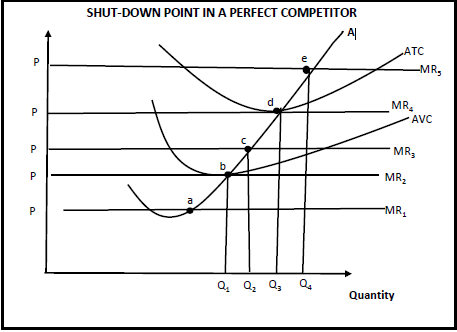
2.2.1 Identify the shut-down point from the graph above. (1)
2.2.2 Name the curve depicted by letter A. (1)
2.2.3 Briefly describe the concept shut-down point. (2)
2.2.4 Describe the nature of the products in perfect competition. (2)
2.2.5 What effect does the entrance of new firms have on the perfect market? (4)
2.3 Study the information below and answer the questions that follow.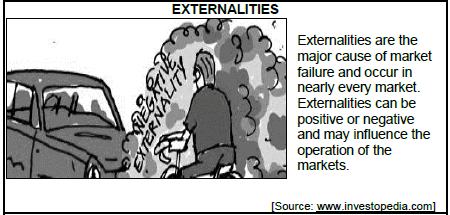
2.3.1 Identify the type of negative externality depicted by the picture above. (1)
2.3.2 Name any ONE method used by government to reduce negative externalities. (1)
2.3.3 Briefly describe the concept negative externality. (2)
2.3.4 Explain how demerit goods cause market failure. (2)
2.3.5 Why would the government intervene in the operation of markets? (4)
2.4 Briefly explain the long run equilibrium position of a monopolist with the aid of a fully labelled graph. (8)
2.5 Why does the government provide merit goods and services? (8)
[40]
QUESTION 3: CONTEMPORARY ECONOMIC ISSUES 40 MARKS – 30 MINUTES
3.1 Answer the following questions.
3.1.1 List any TWO approaches to devising command and control. (2)
3.1.2 What is the impact of COVID-19 on foreign tourists into South Africa? (2)
3.2 Study the information below and answer the questions that follow.
THE CARBON BRIEF PROFILE: SOUTH AFRICA South Africa is the world’s 14th largest emitter of greenhouse gases (GHGs). Its carbon dioxide CO2 emissions are principally due to a heavy reliance on coal. However, a recently released draft electricity plan proposes a significant shift away from the fuel towards gas and renewables. Coal would continue to play a role for decades, the plan would see no new plants built after 2030 and four-fifths of capacity closed by 2050. [Source: www.carbonbrief.org] |
3.2.1 Identify, from the extract, the most emitted greenhouse gas in South Africa. (1)
3.2.2 State the industry that contributes most to global warming. (1)
3.2.3 Briefly describe the concept renewable resources. (2)
3.2.4 Explain voluntary agreements as means by the government to sustain the environment. (2)
3.2.5 How would consumers contribute in reducing climate change? (4)
3.3 Study the information below and answer the questions that follow.
SA RECORDS IN DOMESTIC TOURISM GROWTH The period from January to April 2019 showed exceptional growth on domestic tourism front. Domestic tourism trips rose by 59,7% – a staggering achievement. SA Tourism has been focusing on marketing campaigns that entice South Africans to travel in their country. [Source: www.tourismtattler.com] |
3.3.1 Name ONE marketing campaign that has resulted in growth in domestic tourism. (1)
3.3.2 State any ONE World Heritage attraction in South Africa. (1)
3.3.3 Briefly describe the concept domestic tourism. (2)
3.3.4 Explain the negative effects of tourism on the local community. (2)
3.3.5 How does tourism differ from other service industries? (4)
3.4 Explain the Kyoto Protocol as a major international protocol and agreements on sustainable development. (8)
3.5 Examine the negative effects of globalisation on environmental sustainability. (8)
[40]
QUESTION 4: MICROECONOMICS AND CONTEMPORARY ECONOMIC ISSUES 40 MARKS – 30 MINUTES
4.1 Answer the following questions.
4.1.1 Name any TWO criteria that an activity must satisfy to be a tourism activity. (2)
4.1.2 What would happen if one firm in a perfect market decides to increase its selling price? (2)
4.2 Study the extract below and answer the questions that follow.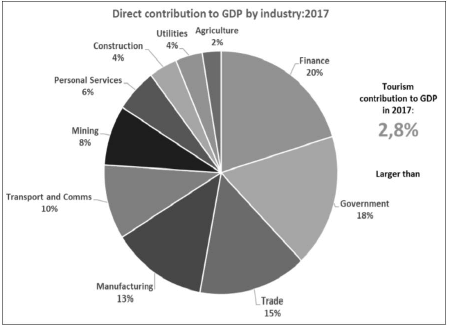
[Source: Medium presentation for the Tourism satellite account for SA: 2017]
4.2.1 Identify the sector that contributed the least in GDP in 2017. (1)
4.2.2 What was the total contribution of tourism to GDP in 2017? (1)
4.2.3 Briefly describe the concept manufacturing. (2)
4.2.4 Explain how creative representative bodies distribute tourists effectively to tourist sites. (2)
4.2.5 How does tourism contribute in boosting the economy? (4)
4.3 Study the graph below and answer the questions that follow.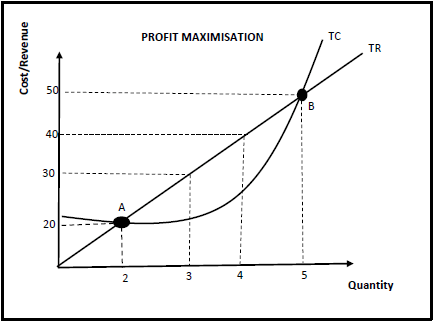
4.3.1 Identify from the graph above, the optimum output level. (1)
4.3.2 At which point from the graph above will the firm break-even? (1)
4.3.3 Briefly explain the concept total cost. (2)
4.3.4 Describe the marginal revenue curve (MR) of a monopoly. (2)
4.3.5 What is the significance of the South African Competition Act? (4)
4.4 Briefly explain the effects of tourism on employment and poverty. (8)
4.5 Examine the effects of setting a maximum price on petrol in South Africa. (8)
[40]
TOTAL SECTION B: 80
SECTION C
Answer ONE of the two questions from this section in the ANSWER BOOK.
Your answer will be assessed as follows.
STRUCTURE OF ESSAY | MARK ALLOCATION |
Introduction
| Max. 2 |
Body Additional part: Give own opinion/Critically discuss/Evaluate/Critically evaluate/Draw a graph and explain/Use the graph given and explain/Complete the given graph/Calculate/Deduce/Compare/Explain/Distinguish/ Interpret/Briefly debate/How/Suggest | Max. 26 |
Max. 10 | |
Conclusion
| Max. 2 |
TOTAL | 40 |
QUESTION 5: MICROECONOMICS 40 MARKS – 40 MINUTES
- Discuss in detail, without the use of graphs, the characteristics of an oligopoly. (26 marks)
- Examine the negative impact of oligopolists behaviour on consumers.(10 marks) [40]
QUESTION 6: CONTEMPORARY ECONOMIC ISSUES 40 MARKS – 40 MINUTES
- Examine in detail the consequences of inflation. (26 marks)
- Why is high inflation a concern for business performance? (10 marks) [40]
TOTAL SECTION C: 40
GRAND TOTAL: 150
Economics Paper 1 Memorandum - Grade 12 September 2021 Preparatory Exams
MEMORANDUM
SECTION A (COMPULSORY)
QUESTION 1
1.1 MULTIPLE-CHOICE QUESTIONS
1.1.1 B amplitude
1.1.2 A factor
1.1.3 C ad valorem
1.1.4 B the R depreciated against the $
1.1.5 D fiscal
1.1.6 D Beneficiation
1.1.7 C 3–6%
1.1.8 A World Bank (8 x 2) (16)
1.2 MATCHING ITEMS
1.2.1 F the difference between what a country exports, including gold, and what it imports
1.2.2 C producers and consumers can to buy goods and services from anywhere in the world without the interference of government
1.2.3 H the movement of goods, services and factors of production among the participants in the economy
1.2.4 A embedded in demand and supply side policies
1.2.5 D shows relationship between tax rates and tax revenue
1.2.6 B increase potential for large scale production
1.2.7 E the return of land to those who lost it because of discriminatory laws
1.2.8 G measured by dividing the real GDP by the number of workers employed (8 x 1) (8)
1.3 GIVE ONE TERM
1.3.1 Circular flow
1.3.2 Recession
1.3.3 Nationalisation
1.3.4 Globalisation / International trade
1.3.5 Spatial Development Initiative
1.3.6 Economically Active Population (6 x 1) (6)
TOTAL SECTION A: 30
SECTION B
Answer TWO of the three questions in this section in the ANSWER BOOK.
QUESTION 2: MACROECONOMICS
2.1
2.1.1 Name any TWO problems of public sector provisioning
- Accountability
- Efficiency
- Assessing needs
- Pricing policy
- Parastatals
- Privatisation/Nationalisation (Any 2 x 1) (2)
2.1.2 Why is borrowing not a long-term solution for a fundamental BOP disequilibrium?
- This is because borrowing is unsustainable in the long term and countries will be burdened with high interest rate payments
- Countries with large interest payments are unlikely to spend on their investment
(Accept any other correct relevant response.) (Any 1 x 2) (2)
2.2 DATA RESPONSE
2.2.1 Name ONE example of an injection.
- Investment
- Government spending
- Exports (Any 1 x 1) (1)
2.2.2 Give a formula to calculate aggregate expenditure in an open economy.
- Aggregate expenditure (E) = C +I + G + X – M (1)
2.2.3 Briefly describe the term injection.
- An injection is the introduction of additional money into the economy by investment (I), government (G), and payments for exports (X).
(Accept any other correct relevant response.) (2)
2.2.4 What is the effect on national income if injections are less than withdrawals?
- The national income decreases. (2)
2.2.5 Suppose the expenditure function ( E ) = 10 + 0.5Y. Draw a clearly labelled 45° diagram to show the expenditure function.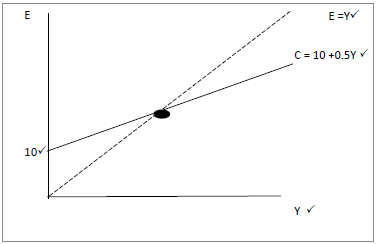
Correct positioning and labelling of 45° = 1 mark
Correct labelling of the vertical intercept = 1 mark
Correct drawing and labelling of the expenditure function = 1 mark
Correct labelling of the axis = 1 mark (4)
2.3 DATA RESPONSE
2.3.1 Give an example of a leading indicator.
- Job advertisements / inventory / sales (1)
2.3.2 Indicate the phase of a business cycle that has the highest unemployment rate.
- Depression (1)
2.3.3 Briefly describe the term business cycle
- Business cycle is a successive period of increasing and decreasing economic activity.
(Accept any other relevant correct response.) (2)
2.3.4 Explain the Keynesian approach of business cycles
- The Keynesian approach holds the view that markets are inherently unstable and therefore government intervention may be required. The price mechanism fails to co-ordinate demand and supply in markets and this gives rise to upswings and downswings. (2)
2.3.5 How can the South African Reserve Bank prevent the economy from reaching a trough?
The Reserve bank can:
- adjust the interest rate (repo rate) downwards, that will make loans and credit cheaper and stimulate aggregate demand
- decrease cash reserve requirements to make more money available at banks, for loans
- buy securities in the open market to make money available for loans (open market transactions)
- persuade commercial banks to act responsibly
- increase the money supply
(Accept any other correct relevant response) (Any 2 x 2) (4)
2.4 Draw a fully labelled graph to show the relationship between inflation and unemployment.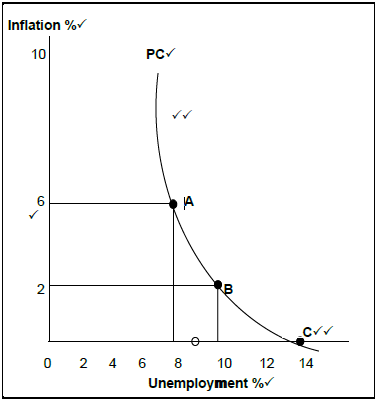
Mark allocation:
Correct shape and positioning of PC = 2 marks
Labelling of PC = 1 mark
Correct labelling of axes = 2 marks
Labelling on axis = 1 mark
Identification of natural unemployment rate point = 2 marks (8)
2.5 Assess the limitations of comparative advantage theory for countries involved in international trade.
Comparative advantage theory has been criticised because of the following limitations:
- Transport costs, tariffs and exchange rates may change the relative prices of goods and may distort comparative advantages between the countries / Transport costs may outweigh any comparative advantage
- Increased specialisation may lead to diseconomies of scale
- Governments may restrict trade
- Imperfect competition may lead to prices being different to opportunity cost ratios.
- Comparative advantage theory does not take into account of some of the more dynamic elements determining world trade for example capital, may come outside the scope of the theory.
- Trade gains do not mean that everyone will become better off – workers in uncompetitive industries may struggle to gain employment in new industries.
- It does not take into account complexity of global trade where in the real world, there are multiple goods and countries being traded between countries.
(Accept any other correct relevant response.) (8)
[40]
QUESTION 3: ECONOMIC PURSUITS
3.1
3.1.1 Name any TWO indicators relating to money supply.
- M1
- M2
- M3 (Any 2 x 1) (2)
3.1.2 How does education help in social development?
- As a process of learning and expanding culture, education contributes to the improvement of the human condition through better knowledge, health, living conditions, social equity and productivity.
- It is a central tool for social progress.
(Accept any other correct relevant response) (Any 1 x 2) (2)
3.2 DATA RESPONSE
3.2.1 Give a formula to calculate per capita income.
- GDP/population (1)
3.2.2 Identify the side where longer life expectancy is experienced.
- North
(Accept any other correct relevant response.) (1)
3.2.3 Briefly describe the term North-South divide.
- Refers to the developed countries in the Northern hemisphere and the developing countries in the Southern hemisphere. (Accept any other correct relevant response) (2)
3.2.4 Compare poverty levels of the North and South countries.
- The North has very low levels of poverty and in the South half the population lives below the poverty line.
(Accept any other correct relevant response) (Any 1 x 2) (2)
3.2.5 How do countries in the ‘south’ negatively affect the environment?
Countries in the ‘south’ negatively affect the environment by:
- engaging in methods of production that are not environmentally friendly.
- Not implementing environmental regulations
- focusing on agriculture, which depletes their natural resources such as soil and water
- lacking in water conservation solutions
(Accept any other correct relevant response) (Any 2 x 2) (4)
3.3 DATA RESPONSE
3.3.1 Identify an indicator related to interest rates.
- Repurchase/repo rate (1)
3.3.2 Name the type of exchange rate system used in South Africa.
- Free-floating exchange rate (1)
3.3.3 Briefly describe the term prime rate.
- The prime rate is the interest rate that commercial banks charge their most creditworthy corporate customers.
(Accept any other correct relevant response.) (2)
3.3.4 Why is it important for the government to assess the performance of the economy ?
- To be able to make informed decisions for planning purposes and compiling policies to improve the economy
(Accept any other relevant correct response.) (2)
3.3.5 How can an increase in repo rate affect consumption expenditure?
- Higher interest rates mean that consumers do not have as much disposable income and must cut back on spending.
- As interest rates rise, bond prices fall.
- The longer the maturity of the bond, the more it will fluctuate in relation to interest rates.
(Accept any other correct relevant response.) (Any 2 x 2) (4)
3.4 Discuss tariffs and quotas as methods of import substitution.
Tariffs
- Customs duties or import duties are taxes on imported goods.
- They can be ad valorem (based on the value) or specific to certain goods.
- Prices of imported goods increase for domestic consumers, and they tend to shift demand from imports to domestic products (goods) (Any 2 x 2)
Quotas
- Limits are put on the supply of goods and services.
- Supply is reduced and prices rise.
- Foreign enterprises benefit if demand for their products remains high.
(Accept any other correct relevant response) (Any 2 x 2) (8)
3.5 How can the Expanded Public Work Programmes be used to reduce the unemployment rate?
EPWP can be used by:
- Investing on (labour-intensive) infrastructural development while creating job opportunities.
- Provision of skills that can help the communities to become employable.
- Giving ordinary citizens the opportunity to establish their own business using skills acquired from the programme.
- Providing workers with a combination of work experience and training.
- Improving the lives of South Africans by building and maintaining community assets and providing services to communities.
(Accept any other correct relevant response.) (8)
[40]
QUESTION 4: MACROECONOMICS AND ECONOMIC PURSUITS
4.1
4.1.1 Name any TWO incentives used by the SA government to improve industrial development.
- Small Businesses Support Program
- SEDA Technology Program (STP)
- Skills Support Program (SSP)
- Critical Infrastructure Facilities
- Custom-free incentives
- Foreign investment incentives
- Strategic Investment Program
- Services to Business Processes (Any 2 x1) (2)
4.1.2 How can a country improve the terms of trade?
It can improve the terms of trade by:
- raising the quality of exports so that they match those of other competitors in the international market.
- increasing the price of exports and decreasing the price of imports.
(Accept any other correct relevant response) (Any 1 x 2) (2)
4.2 DATA RESPONSE
4.2.1 Give ONE example of taxes on products.
- VAT
- Taxes on imports
- Taxes on exports
(Accept any other correct relevant response.) (1)
4.2.2 Identify the method used to calculate Gross Domestic Product
- Income method (1)
4.2.3 Briefly describe the term consumption of fixed capital.
- Is the depreciation in the value of fixed assets that occurs during the production process.
(Accept any other correct relevant response.) (2)
4.2.4 Determine the value of A above.
- R4 523 581
(Accept any other correct relevant response.) (2)
4.2.5 Why does the government provide subsidies on products?
- To make certain products more affordable e.g. brown bread
- To increase production
- To increase exports
(Accept any other correct relevant response.) (Any 2 x 2) (4)
4.3 DATA RESPONSE
4.3.1 Give any other example of a basic service.
- Refuse removal
- Eletricity
- Sanitation
(Accept any other correct relevant response.) (Any 1 x 1) (1)
4.3.2 Indicate the percentage of South African households who do not have access to improved water sources.
- 11,8% (1)
4.3.3 Briefly describe the term social indicator.
- Measures that economists use to evaluate the performance of a country in terms of the social well-being of its citizens.
(Accept any other correct relevant response) (Any 1 x 2) (2)
4.3.4 What measures can be used to ensure sufficient water supplies in South Africa?
- Educate to change consumption and lifestyles
- Invent new water conservation technologies
- Recycle wastewater
- Improve irrigation and agricultural practices
- Appropriately price water.
- Develop energy efficient desalination plants.
- Improve distribution infrastructure.
(Accept any other correct relevant response.) (Any 1 x 2) (2)
4.3.5 How successful has the South African government been in rendering services as a social indicator?
Successes:
- The National Electricity Regulator reports that 85,4% of households in South Africa had access to electricity in 2013. The figure in 2010 was 83,5%
- Some 66% of households in South Africa had access to refuse removal by local authorities once a week
- 89% of South Africans had access to clean water in 2013
- In South Africa, free basic water comprises 6 000 litres per household per month
- 77,9% of households in South Africa in 2013 had access to functioning basic sanitation
- This includes flush toilets, chemical toilets and pit toilets with ventilation pipes
Failures:
- Currently, the country is challenged by illegal electricity connections and power-cuts
- Municipalities are failing in their endeavour to collect refuse as expected
- There are still areas in South Africa with bucket toilets without proper ventilation systems
- Some areas in the country are facing serious water challenges, whereby people and animals have access to the same contaminated water resources
(Accept any other correct and relevant response) (Any 2 x 2) (4)
4.4 Briefly discuss prevention of dumping and protection of natural resources as arguments in favour of protectionism
Prevention of dumping
- Some countries sell their surplus goods in a foreign country at lower prices than it cost them to produce the goods.
- Local producers cannot compete, and their factories may close.
- In the long term, constant undercutting of local prices will force the domestic industry out of business and allow the foreign business to establish itself as a monopoly
- These foreign monopolies will soon increase prices and exploit consumers (2 x 2)
Protection of natural resources
- Free trade can easily exhaust natural resources.
- Therefore protection is needed to protect local industries and indigenous knowledge systems so that they can survive.
- The South African government has taken steps to protect Rooibos tea as natural resource and safeguard indigenous knowledge that allows the hoodia plant to be used for medicinal purposes.
(Accept any othe correct relevant response) (2 x 2) (8)
4.5 How can the Reserve Bank effectively reduce the deficit on the balance of payments?
The deficit can be reduced by:
- Encouraging the country if experiencing deficits to borrow money from other countries
- Borrowing: a country is nevertheless not having a long-term solution for fundamental balance of payments disequilibrium
- Borrowing from the International Monetary Fund (IMF) in the event of fundamental disequilibrium, as a member country
- Increasing interest rates will decrease spending, including on imports
- Using supply side policies to improve the competitiveness of domestic industry and exports
- For example if the government pursued a policy of privatization and deregulation, it may help to increase the efficiency of the economy because of the profit movite in the private sector.
(Accept any othe correct relevant response) (8)
[40]
SECTION C
QUESTION 5: MACROECONOMICS
- Discuss in detail the reason(s) for public sector failure (26 marks)
- How can inefficiencies contributing to public sector failure be solved? (10 marks)
INTRODUCTION
- Public sector failure occurs when the government fails to manage the economy and the resources under its control optimally. / Public sector failure can be regarded as a failure of government to achieve its objectives.
(Accept any other correct relevant introduction.) (2)
MAIN PART
Management failure
- Ignorance, e.g. implementing conflicting policies or wrong policies,
- Incompetence, that is, lack of skill or ability to do a task properly. This may be due to improper qualifications, lack of training, experience and an attitude of apathy
- This may lead to wrong decisions and low productivity
- Corruption: i.e. exploiting of a person’s position for personal gain. Taking bribes, committing fraud, nepotism, behaving dishonestly and committing discrimination.
- Allowing rent-seeking which is behaviour that improves the welfare of somenone at the expense of the welfare of others.
Apathy
- Successful public production relies on long-term accountability.
- It is not always easy to hold the public sector accountable because of the huge workforce of the various departments
- Poor accountability can lead to inefficiencies such as corruption, poor service delivery.
- People employed by the state do not always serve the interests of the public
- They seek to maximise their salaries, status and power and are not required to produce a profit and loss statement
- They are budget driven
- Poor accountability is the result of low motivation, poor training, lack of competence.
Lack of motivation
- Frontline workers rarely receive incentives for successful service delivery.
- There is little stipulation for service quality or quantity.
- No measurement of effectiveness or productivity and few rewards and penalties for it.
- There are not enough systems in place to evaluate the services that government employees give
- The provider only monitors inputs and compliance with processes and procedures
- This leads to limited services that are poor quality and expensive and government departments that are inefficient and ineffective.
Bureaucracy (official rules and procedures)
- Bureaucracy makes policies: take long to implement or it is not implemented successfully.
- Officials may focus on correct procedures and rules and are indifferent to the quantity (e.g. the number of patients attended to) and quality of the service (e.g. explaining the use of the medicine) Some may be insensitive to the needs of their clients.
- Because of self interest, bureaucrats can manipulate policies to benefit themselves at the expense of the people
Politicians
- Politicians tend to promote policies and spend money on projects as long as they get votes in return.
- These policies might involve an inefficient allocation of resources.
- Politicians can also serve their own interests through corruption, personal and hidden agendas and suspicious motives
Structural weaknesses
- Objectives are not met.
- For example, full employment and houses for all are not realisitic and attainable objectives
- Some objectives may work against each other and cause the government not to reach their macroeconomic objectives
- e.g. government redistributes income and wealth too aggressively, economic growth and development could suffer in the long term
Special interest groups
- Groups such as labour unions and business groups can also cause government failure.
- Trade unions can influence the government to pass certain laws to favour their members
- Business groups can, for example, influence the government to provide them with profitable contracts and favourable regulations.
- They can also influence the government to distribute resources so that they can benefit at the expense of the country.
How can inefficiencies contributing to public sector failure be solved?
- Taxpayer’s money can be used to ensure optimal allocation of resources e.g. subsidise students tuition fees on merit
- Protection of industries of strategic importance e.g. the textile industry that are labour intensive
- Monitor spending of government funds on social services budget related to avoid nepotism and corruption
- Put structures and policies in place to take care of the environment directly e.g. increase the number of security staff to prevent animals e.g. rhinos to become extinct
- Take care of the environment indirectly through programmes to make the communities aware of the state of the environment e.g. more environmental programmes on TV and grass root level
- Human rights must be honoured to ensure cooperation at all levels of government
- Reducing bureaucracy by investing in modern systems, such as IT systems
(Accept solutions that relate to bureaucracy, incompetence or corruption) (10)
CONCLUSION
- The South African Government’s latest growth plan, the Economic Reconstrcution and Recovery Plan (ERRP) of 2020, has seen few short-term goals achieved with progress that has been mainly diagnostic e.g establishment of committees, funds and increased state employment.
(Accept any other relevant higher order conclusion.) (2)
[40]
QUESTION 6: ECONOMIC PURSUITS
- Discuss in detail South Africa's initiatives in regional development. (26 marks)
- Evaluate the success of South Africa's regional development policies in terms of international benchmarking. (10 marks)
INTRODUCTION
Regional development refers to policies which are aimed at increasing the economic livelihood of specific areas or regions.
(Accept any correct relevant introduction.)
MAIN PART
Special economic zones (sez’s)
- These are geographical areas of a country set aside for specifically targeted economic activities
- These activities are supported through special arrangement that may include laws and support systems that promote industrial development
- They are meant to expand the manufacturing sector
- Create additional industrial hubs so that the national industry base will be regionally diversified
- These areas may enjoy incentives such as tax relief and support systems to promote industrial development
- There are plans to reduce tax to 15% as an incentive to attract new industries
- The aim of creating SEZ is to attract :
- only new business
- business which are developing a new product line
- business which are expanding their volume
- The DTI has indicated that the existing IDZs where special tax incentives do not apply, would be graduated into SEZs
- It creates a basis for a broader range of industrial parks and provide economic infrastructure to promote employment
Corridors
- Corridors in South Africa are spatial areas that offer specific advantages to mining, manufacturing and other businesses
- The advantages also include the presence of existing infrastructure and the specialisation of products or services
- These corridors are development areas within South Africa and are the development priorities of all development agencies
- The DTI provides help in support of the development corridors
- The Maputo Corridor, that starts in Gauteng and extends through Mpumalanga to the Maputo port, offers opportunity to the transport industry or the Phalaborwa subcorridor in the Limpopo Province offers opportunities for mining and related activities (8)
Spatial development initiatives (SDI’s)
- This is an area with high levels of unemployment and poverty that has been identified by the government for a co-ordinated effort to develop the economic potential of the area
- The area chosen for an SDI must be under-developed and have the potential for sustainable growth
- The development focuses on high level support in areas where socio-economic conditions need concentrated government assistance
- These initiatives help to spread economic activities equally in the country
- All investment is based on public-private partnerships
- It is a government strategy of investment that involves the department of trade and industry (DTI) and transport (DoT)
- It focuses on government attention across national, provincial and local government levels to ensure that investment are fast-tracked and that the maximum synergy between the various types of investments
- These projects are expected to create new jobs well into the future
- The success of these projects relies on a strong move towards international competitiveness, regional cooperation and a more diversified ownership
base
(Accept any other correct relevant response.)
Industrial Development Zones
- This is a purpose built industrial estate, physically enclosed and linked to an international port or airport with duty free incentives
- It was designed to encourage international competitiveness in SA’s manufacturing sector
- IDZ’s fall outside domestic customs zones and therefore able to import items free of customs and trade restrictions, add value, and then exports their
goods - They are designed to attract new investment in export-driven industries. Thus encouraging exports, economic growth and employment
- IDZs are the responsibility of provincial and local government
- Businesses develop around the IDZs (banking, personnel, insurance, auditing, IT, communication, accommodation, catering, shopping, transport)
- IDZs strengthen and stimulate economies in their immediate environments
- Each IDZ offers direct links to an international port or airport, world-class infrastructure, a zero rate VAT on supplies from South African sources, government incentive schemes, reduced taxation for some products, access to latest information
(Accept any other correct relevant response.)
(Allocate a maximum of 8 marks for the mere listing of facts/examples)
(Max. 26)
ADDITIONAL PART
Evaluate the international success of South Africa’s regional development policies in terms of the benchmark criteria
SA has been successful in its Regional Development Policies as:
- interventions in industries are based on sound economic research and analysis which lead to growth-formulation of NIPF on which the IPAP 2018/2019– 2020/2021 are based.
- provision of subsidies and incentives enabled substantial progress and growth in the upgrading of value-adding and labour intensive manufacturing sectors - Black Business Supplier Development Programme, Foreign Investment Grant, SEDA Technology programme etc
- great success was achieved in combating customs fraud, and targeting illegal imports and products of inferior quality through import restrictions by Customs Control Act, the Customs Duty Act, the International Trade Administrations Act and the Counterfeit Goods Act.
- an alignment of trade policy with industrial policy took place through the Department of Trade and Industry (DTI) as one of its objectives.
- it resulted in South African industries being more competitive in the global market.
SA has been unsuccessful in its Regional Development policies as:
- industries have closed down due to the withdrawal of financial support by the government.
- there are no traces of good governance due to corruption and nepotism, e.g. State capture.
- lack of accountability and transparency as a result programmes are not correctly monitored and evaluated.
- policies are only implemented for a short term goal (no sustainability), e.g. programme like EPWP for human resources and protection policies for natural resources.
- No integration as development is still centralised in towns and cities
- There is still a wide gap between development of urban and rural areas in terms of infrastructure.
(Accept any other correct relevant response.)
CONCLUSION
The South African government has entered into several agreements and projects that support development in Southern Africa for the benefit of South Africa. (Accept any other relevant higher order conclusion) Max. (2) (2)
[40]
TOTAL SECTION C: 40
GRAND TOTAL: 150